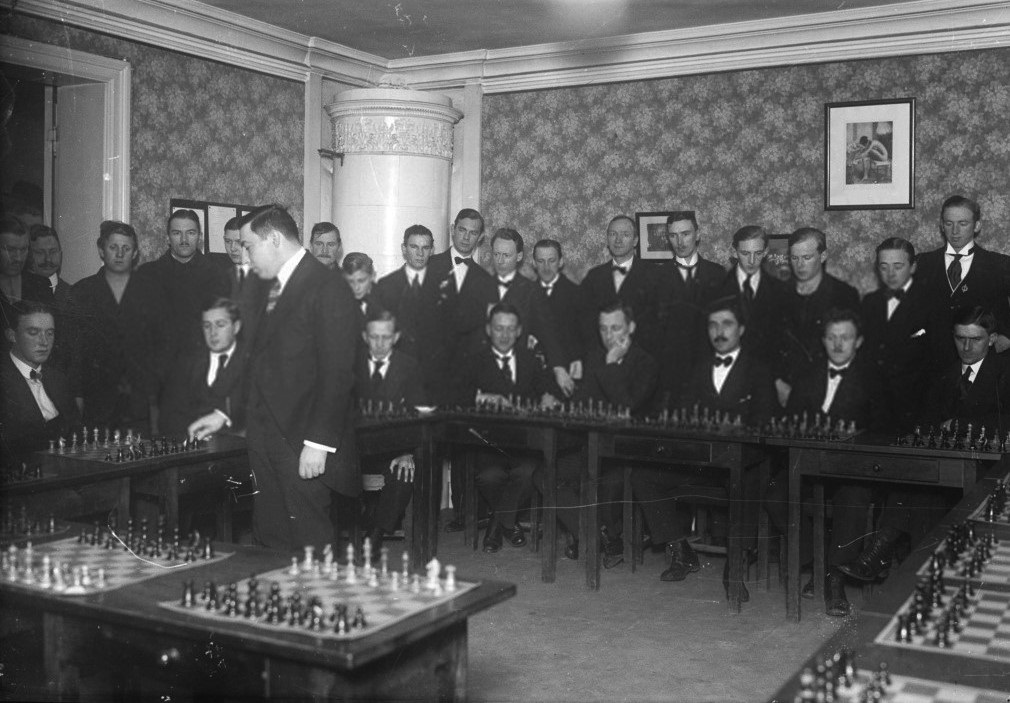
Edward Winter

Akiba Rubinstein (see below)
On page 177 of B.J.Horton’s (highly unreliable) Dictionary of Modern Chess (New York, 1959) W.H. Watts is quoted as saying that Akiba Rubinstein knew ‘by heart almost every game that has ever been played’.
(241)
See Memory Feats of Chess Masters.
From New in Chess, issue 1, page 11 (September 1984):
‘The rule that a player must move his king as punishment after an illegal continuation was taken from the book after the San Sebastián tournament in 1911, when Rubinstein gave the sealed move Kc2-c7 at adjournment in order to peacefully study at home which king move he would choose in the remaining pawn endgame.’
‘Taken from the book’ is meant in the sense of ‘removed’. Soltis’s Lists book (page 41) gives the same story – ‘perhaps apocryphal’. Is it?
(903)
Paul Timson (Whalley, England) writes:
‘I would think the story is almost certainly apocryphal. None of Rubinstein’s games at San Sebastián, 1911 fits the description given. I would also ask whether the rule referred to ever applied to sealed moves anyway. Just possibly the story derived from another incident involving Rubinstein and the sealed move. This was the game Rubinstein-Takács from Budapest, 1926. Rubinstein sealed 39 R-N7, and Kmoch describes the incident as follows:
“This move was handed up by Rubinstein just before the evening intermission. At the resumption of play, a minor incident occurred. Rubinstein came in a few minutes late. Meanwhile the tourney officials had opened the envelope and had made the move R-N2. Rubinstein immediately demonstrated that he had intended R-N7 as his sealed move. After repeated demonstration it became clear that Rubinstein had indicated the text.”’
In passing it may be noted that in the (1922) London Rules it was specified that matches would be played under the British Chess Code with a number of modifications, one of which was: ‘No king penalty for false move, except for the written adjourned move.’
Mr Timson’s analysis above is no doubt correct, but it seems a pity; should writers be deprived of their pleasure of calling Rubinstein a cheat (or Steinitz a madman ... or Alekhine an immoral sadist ...) just because of a want of evidence?
(956)
Mike Forster (Horsham, England) reverts to the topic of penalty moves, mentioning the well-known story about an endgame in which Rubinstein allegedly sealed an intentionally incorrect move, Kc2-c7.
Here we add pages 242-243 of Goldene Schachzeiten by Milan Vidmar (Berlin, 1961). It will be noted that, despite the length of the passage, Vidmar could not give particulars.
On page 502 of the September 1976 Chess Life & Review Tim Krabbé referred to Vidmar’s account, and his next paragraph turned to Breyer v Esser, Budapest, 1917, with a suggestion that White craftily touched his unmovable queen’s rook so as to be ‘forced’ to play a brilliant king move (14 Kf1). However, that was all related by Krabbé merely on a ‘the story has it that ...’ basis.
(8293)
From an interview with Euwe in the September 1981 CHESS (page 200):
[Rubinstein] ‘came to Holland towards the end of the ’30s before his match with Alekhine’.
What match?
Certainly not the same Rubinstein-Alekhine match that Batsford Chess Openings wrongly claims took place (page 99) in 1924. In the ‘corrected edition’ the word match has been removed, but the reference is still wrong. The two players never played any match, and had no over-the-board meetings in 1924.
(917)
Thanks to Rob Verhoeven (The Hague, the Netherlands) we can clear up the curious CHESS reference. The September 1981 issue (page 200) quoted Euwe:
[Rubinstein] ‘came to Holland towards the end of the ’30s before his match with Alekhine’.
This was apparently translated from the August 1981 Europe Echecs, page 373:
‘Au début des années trente, avant son match avec Alekhine, il est venu aux Pays-Bas.’
(We wonder in passing how ‘beginning’ became ‘end’.)
But the French, in turn, came from the 5/1981 Schakend Nederland (page 150) which reads:
‘In het begin van de jaren dertig is hij, vóór mijn match met Aljechin, nog in Nederland geweest.’
Of course, no-one should imagine for a single moment that a correction will now emerge from Sutton Coldfield.
(1249)
Tony Gillam (Nottingham, England) writes:
‘This great player has not so much had a bad press as no press at all. Apart from a book published in the early 1920s, the only book on Rubinstein’s games, until recently, was Kmoch’s Rubinstein Gewinnt! in its various editions. This starts with a game from Carlsbad 1907 and yet before then Rubinstein had played in three All-Russian Championships, the Hauptturnier at Barmen 1905, Łódź 1906 and Ostend 1906 as well as all sorts of events in Poland. The more recent Russian book on Rubinstein does manage to give one game from 1905 and then skips to 1907. Kmoch gives several games by Rubinstein against Salwe at Łódź 1907. What Kmoch probably didn’t realize was that these two players met rather a lot in Łódź in 1907 and 1908. First there was a match of over 20 games (which you will find almost no reference to anywhere), then they met twice in the Autumn 1907 tournament at Łódź, once in the All-Russian Championship (Łódź 1907-8), eight times in the triangular match/tournament which included Marshall, in 1908, and maybe other times as well.
Probably the worst thing about the Kmoch book is Barnie F. Winkelman’s introduction to the English edition. This is chess journalism close to its worst. The impression is given that an unknown Rubinstein walked into the Łódź Chess Club and challenged Salwe to a match. I cannot yet be sure, but I believe that Rubinstein (and Salwe?) had to qualify for the match. Certainly Rubinstein was sufficiently well-known and well thought of to get into the All-Russian Championship in the same year (1903). Horst Helten has recently reprinted the Kmoch book in German with a new foreword in which he states emphatically that the two Salwe-Rubinstein matches were played in the same year. Almost certainly wrong. A 1907 source from Łódź gives two games from each match and indicates 1904 dates for the second match.
I have been through everything from the period in the Dutch Chess Library, so the only way to find new material is from newspaper columns. If any of your readers have access to Polish newspapers from the period, I would like to know.’
(1343)
The May 1881 BCM (pages 166-168) has a game Lord-Ranken, team match, London, 24 March 1881. The opening moves were 1 e4 e5 2 Nf3 Nc6 3 Bb5 Nf6 4 Nc3 Nd4. The Rubinstein Variation, played the year before A.K.R.’s birth.
(1583)
An endnote on pages 260-261 of Chess Explorations referred to a game between Adolf Schwarz and Philipp Meitner (Vienna, April 1878), which opened with 1 e4 e5 2 Nf3 Nc6 3 Nc3 Nf6 4 Bb5 Nd4 (Deutsche Schachzeitung, October-November 1879, page 334). It was also mentioned that the same magazine (May 1875, pages 149-150) had an even older game (Jacob Elson v Eugene Delmar, Philadelphia, 1875), which began 1 e4 e5 2 Nf3 Nc6 3 Bb5 Nf6 4 Nc3 Nd4.
John Owen (Avon, CT, USA) asks for details about a French book on Rubinstein’s endings which he saw on sale in Lausanne a few years ago ...
The work in question is Akiba Rubinstein ou l’art de pratiquer les finales by Krzysztof Pitel, translated from the Polish by Bernard Sojka and published by Hatier (Paris) in 1984.
It seems that the ‘original’ Polish edition did not come out until 1987, under the title Akiba Rubinstein czyli o sztuce rozgrywania końcówek. It contains much more detail than the French book and also reproduces a few contemporary documents.
(1704)
What was the genesis of the only book in which authorship is credited to Rubinstein, La partida de ajedrez (Madrid, 1971)?
(1705)
So far nobody has provided exact details of where Rubinstein’s annotations originated. Ed Tassinari (Scarsdale, NY, USA) remarks that the editor’s note in the book states that the material had been published in the Polish press under the general title ‘The Game of Chess’ and that Rubinstein had intended to bring it together in book form. To rephrase the question: where and when did Rubinstein run a chess column?
(1843)
Richard Lappin (Jamaica Plain, MD, USA) points out that on page 289 of Fred Wilson’s Lesser-known Chess Masterpieces: 1906-1915 (New York, 1976) there is the game Bernstein v Rubinstein (Vilna, 1912) with annotations by Rubinstein from Novoe Vremya. We can find no trace of Rubinstein’s having been a columnist of that publication. For the record, the game culled by Fred Wilson appeared on pages 174-175 of the 1913 Year-Book of Chess (London, 1914).
(1910)
Another little mystery has been a possible chess column by Rubinstein (C.N.s 3120 and 3124). We quoted from page 263 of the September 1918 BCM Alphonse Goetz’s remark that Rubinstein ‘used to conduct in his native town of Łódź a chess column in a little Yiddish paper, printed in Hebrew characters’. Earlier items (C.N.s 1705, 1843 and 1910) discussed the only volume for which authorship is credited to Rubinstein, La partida de ajedrez (Madrid, 1971), but the provenance of most of the annotations in that book also remains unclear.
(3516)
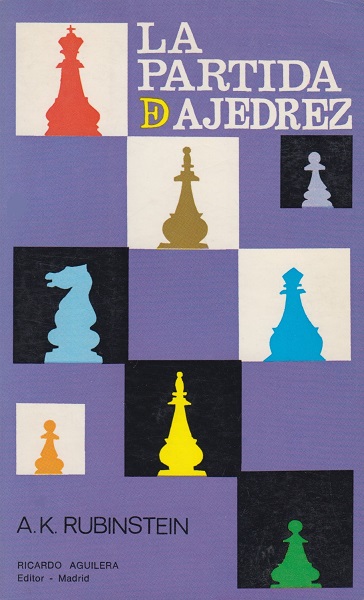
Information about primary sources for annotations by Akiba Rubinstein is still being sought.
He was an occasional contributor to Kagans Neueste Schachnachrichten, and an example follows, from pages 21-22 of the January 1931 issue:
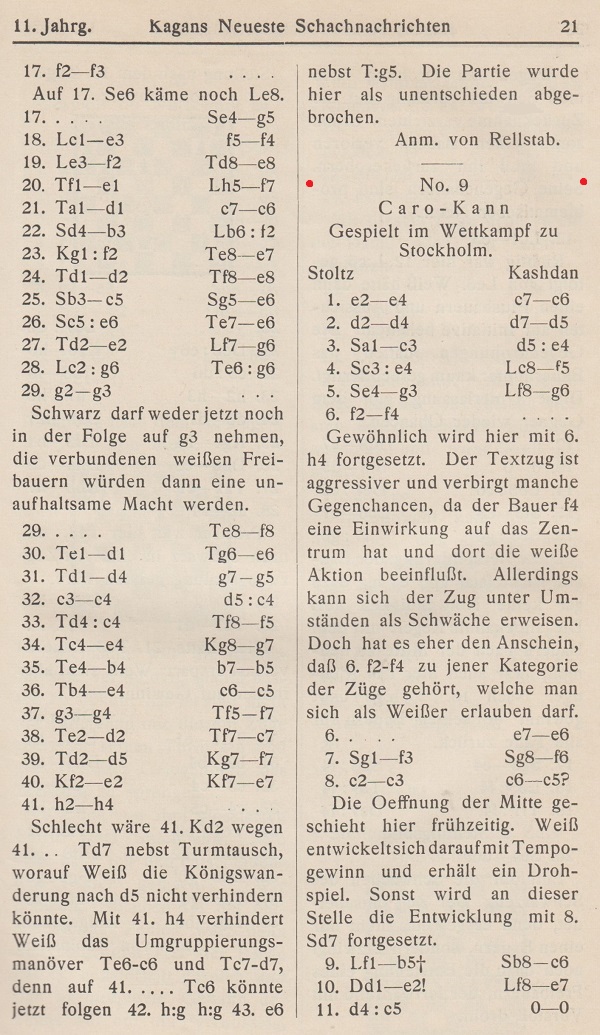
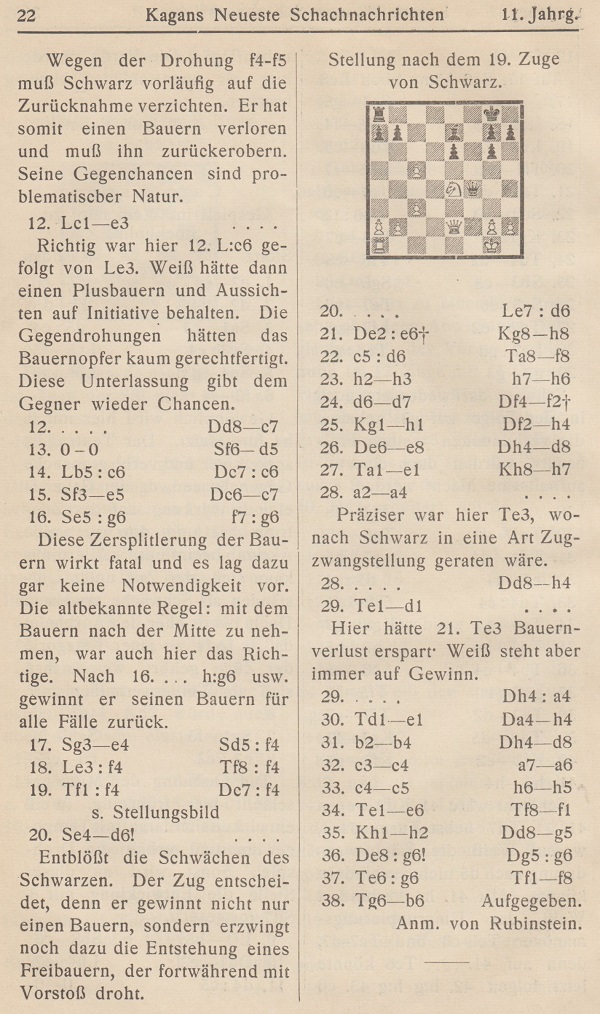
(11692)
From our feature article Boris Spassky:
An interview of fine quality appeared in ‘Portrait of a World Champion’ by Leonard Barden on pages 7-13 of the January 1970 issue of Chess Life & Review. One extract from the interview, which was conducted in 1966:
‘In our time, only when Mikhail Tal appeared did chessplayers see that there could be a different style. Tal has had a great influence on our chess; he stands out in the same way as the old champions. Probably there have been two pure geniuses in chess; Morphy and Capablanca. Tal is also a genius as a tactician, but because he makes a lot of unsound sacrifices this is not pure genius; Morphy and Capablanca hardly ever made tactical mistakes. Perhaps Rubinstein was also a genius of positional chess, and his playing style was also very pure; but he was a bad tactician.’
The following game was won by A.K. Rubinstein’s son, Sammy, in the first championship for French-speaking Belgian players:
Gilles – S. Rubinstein
Brussels, 1980
Ruy López
1 e4 e5 2 Nf3 Nc6 3 Bb5 d6 4 O-O Bd7 5 Re1 Nge7 6 d4 Ng6 7 Bxc6 Bxc6 8 Nbd2 Be7 9 Nc4 O-O 10 Qd3 f5 11 Qb3 Kh8 12 exf5 Rxf5 13 Ne3 Rxf3 14 gxf3 Nh4 15 Nd5 Qd7 16 Kf1 Qh3+ 17 Ke2 Nxf3 18 Qxf3 Bb5+ 19 Ke3 Bg5+ 20 Ke4 Qh4+ 21 Bf4 c6 22 Nc7 Rf8 23 Ne6 Bxf4 24 Qg2 Bd2+ 25 f4 Rxf4+ 26 White resigns.
Source: Chess Horizons, December/January 1980/1981, page 24.
(1940 & 1961)
A footnote on page 66 of Kings, Commoners and Knaves specified that the venue and date were supplied in C.N. 1961 by Karl de Smet (Brussels), who obtained the information direct from Sammy Rubinstein.
‘His style is of extraordinary fineness, and his knowledge of the game can hardly be surpassed by any living player.’
A comment on Rubinstein by Emanuel Lasker in the Neues Wiener Tageblatt, given on page 49 of the February 1914 BCM and reproduced on page 389 of Kings, Commoners and Knaves.
The scores of little-known games by the masters are always appreciated. Jan Kalendovský (Brno, Czech Republic) sends the following:
Akiba Kiwelowicz Rubinstein – Kupczinski
Warsaw, 1914
Four Knights’ Game
1 e4 e5 2 Nf3 Nc6 3 Nc3 Nf6 4 Bb5 Nd4 5 Nxd4 exd4 6 e5 dxc3 7 exf6 Qxf6 8 bxc3 c6 9 Qe2+ Kd8 10 Ba4 Bc5 11 d4 Bxd4 12 cxd4 Qxd4 13 O-O Qxa4 14 Re1 Qb4 15 Rb1 Qf8 16 Bf4 f6 17 Qd2 b6 18 Bd6 Qf7 19 Qf4 Ba6 20 Rbd1 Qxa2 21 Qf5 Bc8 22 Re7 Qa5
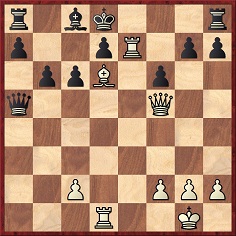
23 Bc5 d6 24 Rxd6+ Kxe7 25 Rd7+ Resigns.
Source: Moskovskiye vedomosti, 2 November 1914 – or 15 November 1914 in the Gregorian calendar.
(1986)
Rubinstein’s Immortal Game against Gedali Abram Rotlewi was played in Łódź but when? Some sources, such as Kmoch’s monograph on Rubinstein, note that both 1907 and 1908 have been given as the year.
The game was published on pages 156-158 of the May-June 1908 Wiener Schachzeitung under the heading ‘Russian National Tournament, Łódź, 26 December 1907’. The tournament took place in December 1907-January 1908. Page 255 of The Year-Book of Chess, 1908 by E.A. Michell reports:
‘The results were some time before they reached England, for the wording of the results and games gave rise to suspicions on the part of the police authorities that the information was cipher of a revolutionary character.
Internal troubles also took place, Rubinstein being accused of coaching Danischevsky in his adjourned game against Alapin, which the former subsequently won. The decision of the Committee in awarding the game to Alapin gave offence to some of the competitors, and these protested by not presenting themselves to play in the following round. This accounts for a discrepancy in the score, whereby some games were forfeited by both players.’
The crosstable shows that one double forfeit was Rubinstein v Rosenblatt. However, as noted by the Year-Book, the table indicates a victory for Danischevsky [Dawid Daniuszewski] against Alapin; ‘hence it is assumed that the committee must have reconsidered their decision’.
(2001)
Emanuel Lasker annotated the Rubinstein’s Immortal Game on page 7 of the New York Evening Post, 18 January 1908, commenting in his introduction that it is ...
‘... a good example of logic combined with imagination, and the pretty finish will no doubt gladden the hearts of those who decry the “dulness” of modern chess.’
An endgame featuring two queens against one is Réti v Rubinstein, Marienbad, 1925. Queens were exchanged at move 16, but three promotions on moves 52-54 led to this position:
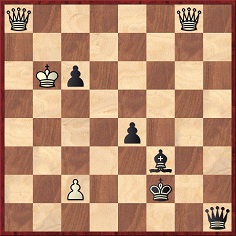
Play continued: 54...e3 55 Qa4 e2 56 Qd4+ Kf1 57 Qd3 Kf2 58 Qd2 Qb1+ 59 Kc7 c5 60 Qb3 Qxb3 61 cxb3 Kf1 62 Qd3 Kf2 63 Qc2 Kf1 64 Qc4 Kf2 65 Qxc5+ Kf1 66 Qc4 Kf2 67 Qd4+ Kf1 68 Qd3 Kf2 69 Qd2 Kf1 70 Qd3 Kf2 71 Qd4+ Kf1 72 Qc4 Kf2 73 Qc5+ Kf1 74 Qc4 Kf2 75 Qd4+ Kf1 76 Qd3 Kf2 77 Qd2 Kf1 78 Qe3 Bg2 Drawn.
(2025)
Gabriel Velasco (León, Mexico) draws attention to a discrepancy in the score of the game Důras v Rubinstein, Carlsbad, 1907. The opening moves were 1 e4 e5 2 Nf3 Nc6 3 Nc3 Nf6 4 Bb5 Bb4 5 O-O O-O 6 d3 Bxc3 7 bxc3 d6 8 Bg5 Qe7 9 Re1 Nd8 10 d4 Ne6 11 Bc1 c6 12 Bf1 Qc7 ...
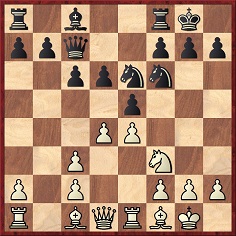
... after which Kmoch’s monograph on Rubinstein (Vienna, 1933) says that White played 13 Nh4, whereas on page 37 of Akiba Rubinstein’s Chess Academy by Viktor Glatman (Moscow, 1992) 13 Ng5 is given. The books agree that there followed 13...Re8 14 Qd3 Bd7 15 g3 Rad8 16 Bg2 Bc8 17 f4 exf4 18 gxf4 Nf8 19 f5, but then Kmoch has 19...h6 and Glatman 19...g6. After 20 Bd2, Black played 20...N8h7 according to Kmoch whereas Glatman gives 20...Kg7. Both books state that the game ended 21 Nf3 Re7 22 h4 c5 23 Nh2 Rde8 24 Re3 b6 25 Bf3 Bb7 26 Rae1 c4 27 Qe2 Bxe4 28 Qg2 d5 29 Bc1 Bxf3 30 Nxf3 Rxe3 31 Bxe3 Re4 32 Qh3 Rg4+ 33 Kh1 Rg3 34 Qh2 Ng4 35 Bg1 Nxh2 36 Bxh2 Qf4 37 Ng1 Qxh4 38 Resigns. The respective annotators (Kmoch and, for the Glatman book, Lputian) naturally offer contradictory assessments of the game, since they were discussing different positions.
The Kmoch version of the score follows the Carlsbad, 1907 tournament book. We have yet to find any source that concords with the moves presented by Glatman’s book.
(2055)
Pages 323-324 of Kings, Commoners and Knaves, presented a further discussion, beginning with a contribution from Richard Forster (Winterthur, Switzerland):
‘Further evidence in favour of the score as given by Kmoch is that in the Glatman version Black could simply win an important pawn by 19...Bxf5.
Incidentally, another Rubinstein game is the subject of an error in several monographs on him (viz. the ones by Kmoch, Glatman and Donaldson/Minev). At move 38 in the game Rubinstein v Tarrasch, Carlsbad, 1923 this position occurred:
Kmoch writes that he cannot believe that 38 Qc4, which is given in contemporary sources, is the right move, because it allows 38 ... Qxe3. Therefore he decided that the move actually played must have been 38 Qc3. Since my analysis proves that White wins a piece after 38 Qc4 Qxe3 39 Qb4!! (39...Qe2 40 Rxb8 Qh5+ 41 Kg2 Qe2+ 42 Kg1 Dd1+ 43 Kf2! or 40...Qf1+ 41 Bg2 Qf5+ 42 g4 Qd3+ 43 Kh4!), I don’t think there is any justification for Kmoch’s altering the game course which has been copied widely.’
It should be noted that on page 97 of Rubinstein Gewinnt! Hans Kmoch wrote after 38 Qc3:
‘Die Bücher und Zeitschriften geben hier übereinstimmend, jedoch ohne Anmerkung 38 Dc4 an. Es is jedoch nicht zu sehen, warum Weiß den Bauer[n] e3 geopfert und Schwarz ihn nich genommen haben sollte.’
This was mistranslated on page 121 of Rubinstein’s Chess Masterpieces (Philadelphia, 1941) as:
‘The books and the newspapers unanimously recommend 38 Q-B4, but without analysis: However, it is not apparent why White sacrifices the pawn at K3, and why Black does not capture.’
In reality, Kmoch was reporting that all the publications had given 38 Qc4 as the move played, not as a recommendation. In short, he unjustifiably altered the score of the game.
Akiba Rubinstein: Uncrowned King by John Donaldson and Nikolay Minev (Seattle, 1994) is the first of a two-volume work and covers the period 1882 to 1920, presenting 474 games, many with both contemporary and modern notes. Players and historians will appreciate the authors’ practice of examining opening variations in the light of modern knowledge. For instance, a game on page 27 begins 1 e4 e5 2 d4 exd4 3 c3 Qe7 4 cxd4 Qxe4+ 5 Be3 Bb4+ 6 Nc3 d5. Black’s sixth move is given an exclamation mark and described as ‘a major improvement over the example shown in ECO’ (6...Nf6).
The book is not without occasional slips, but no previous writers have revealed so much about Rubinstein’s obscure early years. Below is a game played in the event discussed in C.N. 2001 (see pages 317-318 of Kings, Commoners and Knaves):
Akiba Kiwelowicz Rubinstein – Dawid Daniuszewski
Łódź, 17 December 1907
French Defence
1 e4 e6 2 d4 d5 3 Nc3 Nf6 4 exd5 exd5 5 Bg5 c6 6 Bd3 Bd6 7 Nge2 O-O 8 Qd2 Bg4 O-O 9 Nbd7 10 Ng3 Qc7 11 h3 Bxg3 12 fxg3 Bh5 13 Qf4 Qb6 14 Na4 Qa5 Bxf6 Nxf6 16 Nc5 b6
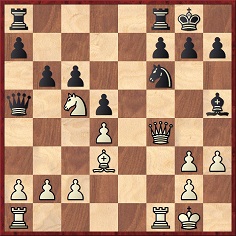
17 Qh4 Bg6 18 Rxf6 gxf6 19 Nd7 Rfd8 20 Nxf6+ Kg7 21 Bxg6 hxg6 22 Qh7+ Kf8 23 Rf1 Qd2 24 Qh8+ Ke7 25 Ng8+ Ke8 26 Nh6+ Resigns.
(2076)
The same authors rounded off Rubinstein’s career in a second volume, Akiba Rubinstein: The Later Years (Seattle, 1995).
From page 154 of Rubinstein’s Chess Masterpieces by Hans Kmoch:
‘Rubinstein played many tournament games against Yates. It is a curious coincidence that Yates almost always had the White pieces.’
We have counted 18 games. Yates was White in 11 of them, including a sequence of nine (from Hastings, 1922 to Budapest, 1926). He was then Black in all five remaining encounters (Bad Kissingen, 1928 to San Remo, 1930). Yates’ total score was +2 –8 =8.
(2091)
In section 33 of Chess Fundamentals Capablanca annotated the game Janowsky v Kupchik, Havana, 1913, which began 1 d4 d5 2 c4 e6 3 Nc3 Nf6 4 Bg5 Be7 5 e3 Nbd7 6 Bd3 dxc4 7 Bxc4 Nb6. At this point the Cuban says that the normal course, 7...O-O, followed by 8...c5, is more reasonable and he recommends as a ‘beautiful illustration of how to play White in that variation’ the game between Janowsky and Rubinstein, St Petersburg, 1914.
Since that encounter began 1 d4 d5 2 Nf3 c5 3 c4 e6 4 e3 Nf6 5 Bd3 Nc6 6 O-O dxc4 7 Bxc4 a6 8 Nc3 b5 9 Bd3 cxd4 10 exd4 Nb4 and was won by Black, who did not castle until his 17th move, it would seem that Capablanca was thinking of a different game. But which one?
(2122)
Concerning The Batsford Chess Puzzle Book by Leonard Barden (London, 2002), page 96 has a position headed “Thomas Middleton v Akiba Rubinstein, Barmen 1905”. Thomas Middleton certainly had a chess connection (he was an English dramatist who wrote A Game at Chess), but since he died in 1627 fate denied him the opportunity of a game against Rubinstein. The player at Barmen, 1905 was E.E. Middleton of Brussels.
Another Rubinstein position, on page 91, is quite a mix-up. It is presented as coming from the game ‘Herman von Scheve v Akiba Rubinstein, Ostend 1907’ (White’s forename should read Theodor):
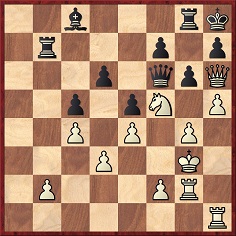
Barden comments that von Scheve played 1 Qxh7+ and only drew by perpetual check. ‘Can you do better and win the game for White?’ The solution on page 168 is: “1 g5! Qe6 (not 1…gxf5 2 Qxf6+) 2 Qxh7+ Kxh7 3 hxg6+ Kxg6 4 Rh6+ Kxg5 5 Kf3 mate.’
Yet Barden’s diagram is incorrect. As is shown by the full game-score in Teichmann’s tournament book (page 42), there was no black bishop on c8 or white rook on g2.
(2907)
The following game from a simultaneous exhibition has been submitted by Jan Kalendovský:
Henryk Podplomyk – Akiba Rubinstein
Częstochowa, 1931
Queen’s Gambit Declined
1 d4 d5 2 c4 e6 3 Nf3 Nf6 4 Bg5 Nbd7 5 e3 Be7 6 Nc3 O-O 7 Bd3 a6 8 a3 h6 9 Bh4 dxc4 10 Bxc4 b5 11 Bd3 c5 12 O-O Bb7 13 Ne5 Rc8 14 Bb1 cxd4 15 exd4 Re8 16 Qc2 Be4 17 Qe2 Bxb1 18 Raxb1 Nb6 19 Rfd1 Nfd5 20 Nxd5 Qxd5 21 Qh5 Bxh4 22 Qxf7+ Kh7 23 Qg6+ Drawn.
Source: Gazeta Częstochowska, 24 September 1974. (No earlier source is currently available.) We note that page 276 of Akiba Rubinstein: The Later Years by J. Donaldson and N. Minev (Seattle, 1995) gave a list, courtesy of Świat Szachowy, 1931, of Rubinstein’s simultaneous displays in Poland that year. In Częstochowa his result was recorded as +18 –2 =5.
(2992)
Capablanca commented on page 8 of the New York Times, 13 February 1927:
‘In the endings, contrary to many people’s idea, Marshall is an A1 performer. To be truthful, he is no Dr Lasker or Rubinstein, when the latter is at his best, but only one or two of his competitors in the coming tournament [New York, 1927] will have the slightest advantage over him in this department of the game.’
(3072)
Concerning the worst start to a tournament, the following is from page 301 of Kings, Commoners and Knaves:
On the sixth move of his first-round game in the Vienna tournament (13 November 1922), Takács blundered away a piece against Rubinstein: 1 d4 Nf6 2 c4 e6 3 Nc3 b6 4 e4 Bb7 5 Bd3 Bb4 6 Qc2 d6 7 Qa4+ Nc6 8 d5. He resigned at move 24.
Databases give several 1990s games with the same blunder (6...d6).
Page 391 of Kings, Commoners and Knaves quoted from an article by Jacques Mieses on pages 260-261 of the August 1940 BCM which included the following:
‘May I finally mention that, of the living great masters, Maróczy and Rubinstein have made a special study of Morphy’s games. They both told me that they believe him to be the strongest player that ever lived.’
From Maarten de Zeeuw (Rotterdam, the Netherlands):
‘There was a forerunner to Lisitsin’s Gambit. S. Freiman-Rubinstein, Vilnius, 1912 started 1 f4 e6 2 Nf3 f5 3 e4 d5 4 exd5 exd5 5 d4 Nf6 and 1-0 after 32 moves. After 3…fxe4 4 Ng5, Black would have gained a tempo, as the move f4 seems useless, but in Freiman-Bogoljubow, St Petersburg, 1914 he was not able to take advantage (4…Nf6 5 d3 h6 6 Nxe4 d5 7 Nf2 and 1-0 after 22 moves).’
Regarding the first of these games, the move-order given by our correspondent is confirmed by various contemporary sources, but page 241 of Akiba Rubinstein: Uncrowned King by J. Donaldson and N. Minev stated that the game began 1 f4 f5 2 Nf3 e6 3 e4 d5 exf5 4 exf5 exf5. An alternative spelling often seen for White’s name is Freymann.
(Kingpin, 2000)
‘Rubinstein was scheduled to play Norman in one of the rounds of the Hastings tournament in 1926. Norman was ready, but there was no sign of the great Polish master.’ That is how an anecdote begins on pages 20-21 of The Bright Side of Chess. Chernev relates that after Rubinstein’s clock had been ticking away for an hour an official found the master asleep in his hotel room. Having rushed to the tournament hall, Rubinstein had only 30 minutes left to make his first 40 moves, yet he went on to win the game when the time-limit was exceeded by Norman.
A problem with this arises from the outset, since Rubinstein did not participate in the Hastings tournaments of 1925-26 or 1926-27. He did, however, play in, and win, the 1922-23 event, defeating G.M. Norman in their individual game (second round, 28 December 1922). The BCM (February 1923, page 34) reported, ‘Rubinstein, though arriving on the scene more than half an hour late (he was usually late!), rapidly polished off Norman’. A source for Chernev’s anecdote remains to be discovered.
The game-score of the Norman v Rubinstein game can be found on page 64 of Akiba Rubinstein: The Later Years by J. Donaldson and N. Minev (Seattle, 1995), although we note that the BCM (February 1923, page 63) gave a further pair of moves at the end (24 Rf1 Qxd3).
(3092)
Reinfeld’s The Joys of Chess (page 284) also had the Rubinstein-Norman story, quoted from a piece by M.E. Goldstein in Chess World, 1946, which began, ‘A memory of Hastings 20 years ago …’ It will be recalled that Chernev unmindfully put 1926 as the date of the alleged episode.(3095)
From pages 20-21 of The Bright Side of Chess by Irving Chernev (Philadelphia, 1948):

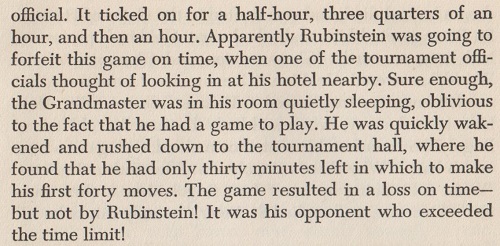
Gerard Killoran (Ilkley, England) draws attention to Norman’s own account, in a chess column by Frank Rhoden on page 10 of the Hastings & St Leonards Observer, 20 April 1957:

(10318)
Alekhine wrote the following in the New York Times, 28 August 1929, pages 19 and 20 (see Alekhine on Carlsbad, 1929):
‘Another, besides the experienced tournament player Capablanca, proved that he is fully conversant with modern chess tactics and that is the Polish grand master, Akiba Rubinstein. All the admirers of this genius of chess will be pleased to hear this. Rubinstein’s career in chess has been original. After sharing first prize with Lasker in the great tournament at St Petersburg in 1909 and winning four first prizes in other large tournaments, all experts and Lasker, the world champion himself, considered Rubinstein qualified to be Lasker’s successor. His innovations in the opening theory and his masterly ability to find microscopic advantages in the final game have procured him a place of high honor in the chess hierarchy.
Then came the World War. In the post-War tournaments was Rubinstein quite changed. He no longer was the calm, methodical strategist who was able to turn the faults, almost imperceptible, of even the greatest players in his favor, but a man who apparently decided to replace his nerves, ruined during the years of the War, with a new temperament in his game. Hereby he obtained an exceedingly large number of brilliancy prizes – at the Teplitz tournament he won five such prizes – but this system did not prove successful for any length of time.
In 1924 and 1925 he suffered heavy defeats and had to change his system again. Luckily he has succeeded. He has realized the necessity of balancing the modern theories of chess with his special talent. That this is the correct point of view is shown in this tournament. The “second chess youth” which Rubinstein is surely approaching will find him, according to his talent, a very great man.’
From page 6 of Akiba Rubinstein: Uncrowned King by J. Donaldson and N. Minev (Seattle, 1994):
‘Judging from the available evidence, Rubinstein probably began his chess career a few years before the turn of the century. The following game is the earliest example that has been preserved and it shows that Rubinstein already possessed good combinative skills. The exact date when it was played is unclear but we would guess sometime during 1900-1902.’
The book then gives (on page 7) ‘Rubinstein v Bartoszkiewicz, Bialystok, 1901 (?)’, a 17-move win for Rubinstein which is too familiar to be repeated here.
Further information would be welcomed. We note that page 38 of Jeugdpartijen van Beroemde Meesters by S. Postma (Venlo, 1984) stated that the game was played by correspondence in 1897.
(3125)
We wish to compile a list of games (mainly from tournaments and matches) whose moves it has so far been impossible to find. One of the most striking cases is Rubinstein v Alekhine, Vilnius, 1912. In instances such as Capablanca v Teichmann, San Sebastián, 1911 part of the game-score is known. Other examples of significant gaps will be welcomed.
(3192)
See Incomplete Games of Chess.
John Donaldson (Berkeley, CA, USA) informs us that he and Nikolay Minev are preparing a second edition of their work on Akiba Rubinstein (published in two volumes in 1994 and 1995). He asks for information about the position below, which appeared under the heading ‘Won by Rubinstein’ on page 32 of Chess Combinations and Traps by V. Ssosin (Middletown, NY, 1936):

White is said to have won with 1 Rh3+ gxh3 2 Kf3 g4+ 3 Kf4 g3 4 hxg3 mate.
(3214)
Michael McDowell (Westcliff-on-sea, United Kingdom) draws attention to the following position by J. Márquez in Ruy López, March 1897:
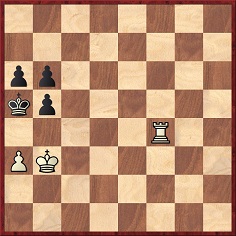
Mate in four
1 Ra4+, etc.
Our correspondent comments that the problem is number 75B in A.C. White’s book The White Rooks (Stroud, 1910).
(3222)
From John Donaldson:
‘Simon Constam of Hamilton, Canada raises a very interesting question. Page 12 of The Grünfeld Defence by William Hartston (London, 1971) gives the sequence 1 d4 Nf6 2 c4 g6 3 Nc3 d5 4 cxd5 Nxd5 5 e4 Nxc3 6 bxc3 c5 7 Nf3 Bg7 8 Be2 O-O 9 O-O b6 10 Be3 Bb7 11 e5 cxd4 12 cxd4 Na6 13 Qa4 Nc7, with the better game for Black, Rubinstein-Alekhine, 1924. I have seen no source on either Rubinstein or Alekhine that gives this game and could find no encounter in MegaDatabase 2005 that reached the position after 13...Nc7. Any help on resolving this mystery would be gratefully appreciated.’
Why and when this faulty game reference started appearing in chess literature is unknown to us, but we mentioned it in C.N. 917 after noting the citation ‘Rubinstein-Alekhine, match 1924’ on page 99 of that gaffes-à-gogo book Batsford Chess Openings (London, 1982).
(3607)
This illustration appears on page 22 of Famous Chess Players by Peter Morris Lerner (Minneapolis, 1973):
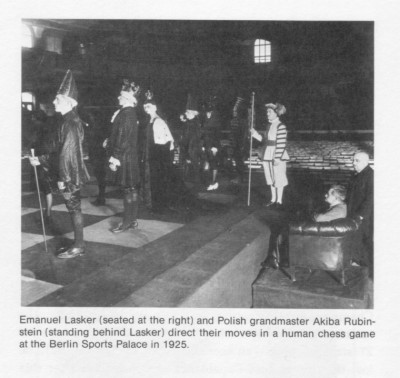
The date 1925 is an error for 1924, but we also suggest that the person on the far right is not Akiba Rubinstein but, probably, Ossip Bernstein. The latter participated in the event, as reported on page 300 of the October 1924 Wiener Schachzeitung.
(3775)
Avital Pilpel (Haifa, Israel) submits two photographs from Shaul Hon’s book Ptichot be’Shachmat (‘Chess Openings’), i.e. the third edition published in Tel Aviv in 1964. The first (from page 9) shows, on the right, the Israeli Prime Minister David Ben-Gurion (1886-1973), with Pinchas Rosen. The latter was a minister in some of the early governments of Israel.
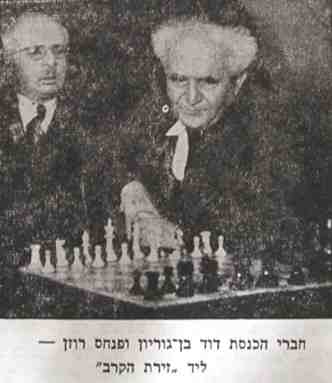
The second photograph (from page 35) was taken during a simultaneous display by Akiba Rubinstein in Palestine in 1931. Seated fourth from the left is the poet Haim Nachman Biyalik.
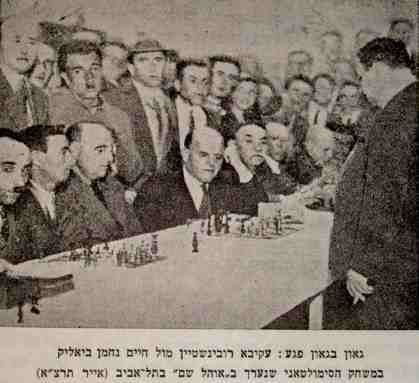
(4149)
From Pierre Bourget (Beauport, Canada):
‘Tartakower’s My Best Games of Chess 1931-1954 was translated from French by Golombek, but I have never seen a book in French by Tartakower for that second period. I am aware of a French edition only for 1905-1930, under the title Tartacover vous parle.’
Tartacover vous parle was published by Librairie Stock, Paris in 1953 and is readily available today, having been re-issued by Payot, Paris in 1992. In common with our correspondent, we have no knowledge of a French edition on the years 1931-54.
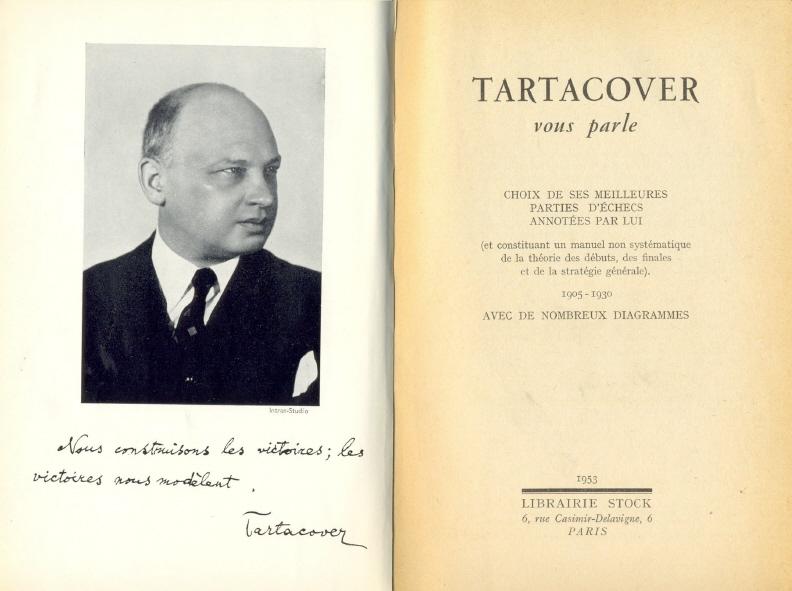
... Tartakower is one of the most difficult chess writers to translate into English (among others are A. Nimzowitsch and F.K. Young), but on one relatively straightforward matter Golombek seems to have gone astray. It concerns the conclusion of Tartakower v Rubinstein, The Hague, 1921. The English edition (page 96) reads:
‘In his obstinate search for a saving clause Black here exceeded the time limit, but play continued, and White’s victory was achieved without taking notice of this disagreeable circumstance in the following way: ...’
The idea that play went on after Rubinstein’s flag had fallen is strange, and Tartacover vous parle (page 139) has something altogether different:
‘Dans la recherche obstinée d’un sauvetage, les Noirs dépassèrent ici le temps de réflexion, mais la victoire des Blancs s’obtenait même sans cette circonstance fâcheuse de la façon suivante: ...’
There is nothing about ‘play continued’ in the French version. A revised English translation would read:
‘In his obstinate search for a saving clause, Black here exceeded the time limit, but even without that disagreeable circumstance White would win, as follows: ...’
Golombek appears to have misunderstood ‘s’obtenait’ and to have set off down a wrong path which prompted him to add the words ‘play continued’.
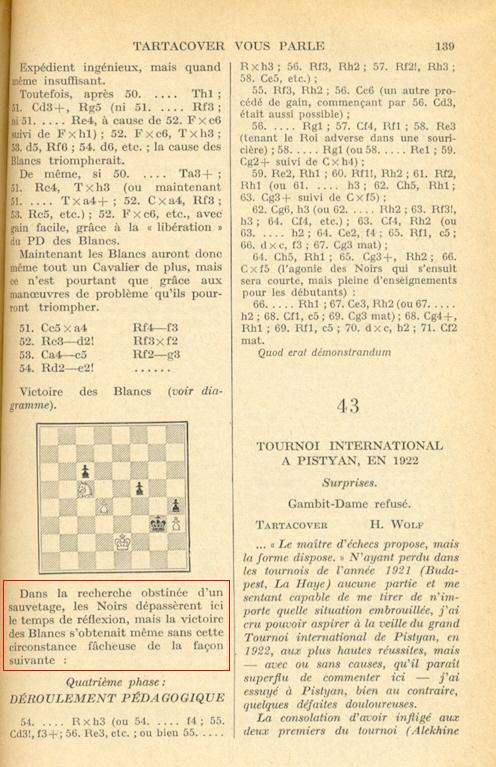
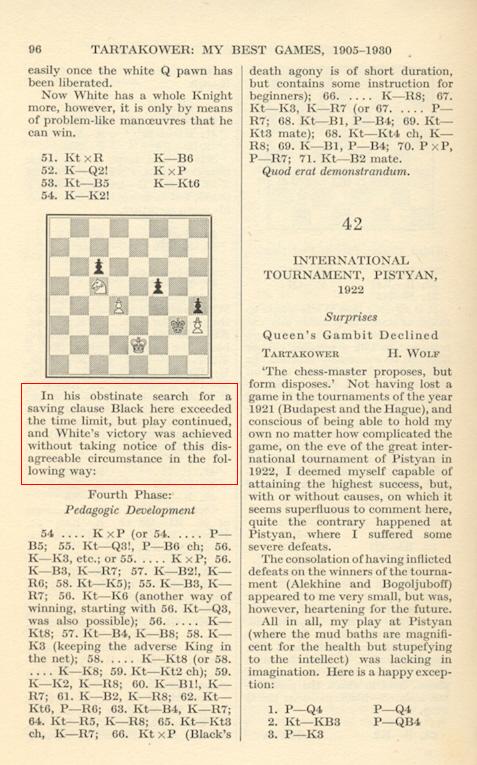
However, one complication still needs to be considered. There exists a German translation, by Rudolf Teschner, of Tartakower’s book, under the title Tartakowers Glanzpartien, 1905-1930. Since it specifically billed itself as a translation from the French original, it would hardly be expected to follow the Golombek version rather than what appeared in Tartacover vous parle, yet it did exactly that:
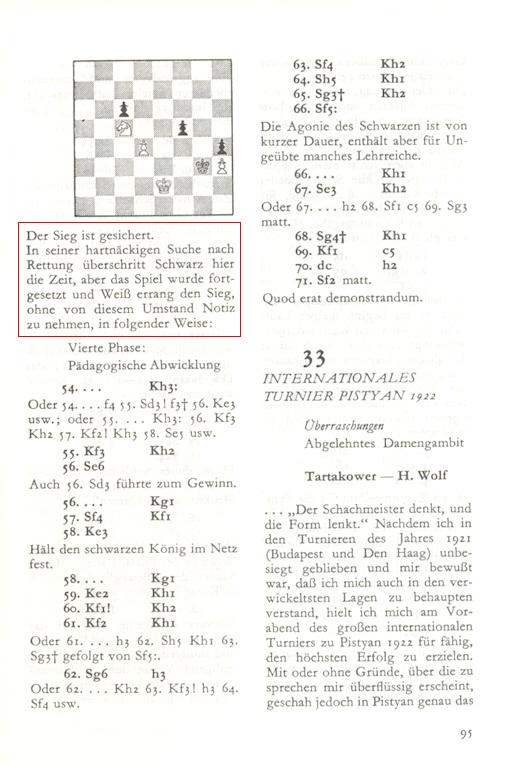
We have found no contemporary (1921) source which suggests that the game continued to 71 Nf2 mate. On page 461 of the December 1921 BCM Sir George Thomas wrote after 53...Kg3, ‘At this stage, Black lost by over-stepping his time-limit. The game could not be saved in any case. A likely continuation would be 54 Ke2 ...’, after which he gave some 20 lines of analysis. See also page 25 of the tournament book by B. Kagan, page 215 of Schachjahrbuch 1921 by L. Bachmann (Ansbach, 1923), page 43 of 500 Master Games of Chess by S. Tartakower and J. du Mont (London, 1952), page 9 of the tournament book by A. Becker and page 19 of Akiba Rubinstein: The Later Years by J. Donaldson and N. Minev (Seattle, 1995).
(4437)
Joost van Winsen (Silvolde, the Netherlands) reports a claim by G.C.A. Oskam on page 39 of Schaakmat, February 1951 that at the 1921 tournament in The Hague Rubinstein began his record of a game on the second row of the score-sheet. According to Oskam, Rubinstein explained himself as follows: ‘There are always players who do not observe the rule of recording every move. They save time by not doing so. In time-pressure they want to profit from my record and look at my score-sheet. They then think that they have only one more move to make, whereas two moves should be made. There is no need for me to help my opponent.’
As already seen in C.N. 4505, Oskam’s stories need to be read guardedly. In any case, we recall only ‘normal’ score-sheets in Rubinstein’s hand. See, for example, page 225 of Akiba Rubinstein: The Later Years by John Donaldson and Nikolay Minev (Seattle, 1995).
(4534)
Karsten Müller (Hamburg, Germany) has been analysing Rosselli v Rubinstein, Baden-Baden, 1925 and asks:
‘Did White play axb5 at some point in the endgame? If not, Rubinstein could have played ...bxa4 followed by ...Rc4 on several occasions. In the game-score as given in the ChessBase Megabase White never took on b5, which seems very strange to me.’
The score as given in virtually every source we have consulted (including pages 49-50 of Tarrasch’s tournament book) does indeed leave open the recurring possibility of ...Rc4, but we have a solution to offer: at move 42 White’s pawn move was not a4 but a3. The latter move is given on page 81 of the Russian tournament book by N.I. Grekov (Moscow, 1927), as shown in the excerpt below:

The full game-score as given in the Russian book is: 1 e4 e5 2 Nc3 Nf6 3 Bc4 Nxe4 4 Qh5 Nd6 5 Qxe5+ Qe7 6 Qxe7+ Bxe7 7 Bb3 Nf5 8 Nf3 c6 9 O-O d5 10 Re1 Na6 11 d4 h5 12 Ne2 Nc7 13 c3 f6 14 Ng3 Nxg3 15 hxg3 g5 16 Bd2 Bf5 17 Re3 Kd7 18 Rc1 Bd6 19 Bc2 Bxc2 20 Rxc2 Rae8 21 Bc1 Rxe3 22 Bxe3 Ne8 23 Re2 Ng7 24 Bd2 Nf5 25 Re1 c5 26 dxc5 Bxc5 27 Kf1 h4 28 gxh4 g4 29 Nd4 Bxd4 30 cxd4 Rxh4 31 Bc3 Rh1+ 32 Ke2 Rh2 33 Rg1 Nh4 34 g3 Nf5 35 b3 Ke6 36 Bb2 a6 37 Bc3 Nd6 38 Ke3 Ne4 39 Be1 Kf5 40 Rf1 Rh8 41 Kd3 b5
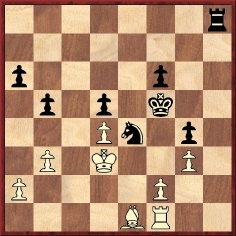
42 a3 (And not 42 a4.) 42...Rh7 43 Ba5 Rh8 44 Bb4 Rc8 45 Ba5 Ng5 46 Bd2 Ne4 47 Ba5 Kg6 48 Bb4 f5 49 Ba5 Rh8 50 Ke3 Re8 51 Kd3 Rc8 52 Bb4 Rc7 53 Ba5 Rh7 54 Ke3 Re7 55 Kd3 f4 56 gxf4 Rh7 57 Bd2 Nxd2 58 Kxd2 Rh3 59 f3 gxf3 60 Rf2 Kf5 61 Ke3 Kg4 62 b4 Rh1 63 f5 Re1+ 64 Kd3 Re4 65 White resigns.
(4625)
Jan Kalendovský submits the following game from page 6 of Dziennik Poznański, 10 April 1931:
Antoni Wojciechowski – Akiba Rubinstein1 e4 e5 2 Nf3 Nc6 3 Bb5 a6 4 Ba4 Nf6 5 O-O d6 6 Re1 b5 7 Bb3 Na5 8 c3 Nxb3 9 axb3 c5 10 Na3 Bb7 11 d3 g6 12 c4 b4 13 Nc2 Bg7 14 Ne3 O-O 15 Bd2 Bc8 16 Qc1 h6 17 h3 Kh7 18 Nf1 Ng8 19 Ng3 f5 20 exf5 gxf5 21 Qc2 f4 22 Ne4 Bf5 23 Kh2 Nf6 24 g4 fxg3+ 25 Nxg3 Bg6 26 Re3 Nh5 27 Rg1 Nf4 28 Ne4 Ra7 29 Rg3 Raf7 30 Qd1 Bf5 31 Bc1 Bf6 32 Re1 Qd7 33 Bxf4 exf4 34 Rgg1 Bd8
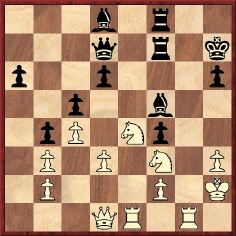
35 Nfg5+ hxg5 36 Qh5+ Kg8 37 Nxg5 Rg7 38 Ne6 Qxe6 39 Rxe6 Bxe6 40 Re1 Bf5 41 Qf3 Rh7 42 Qd5+ Kg7 43 Qxd6 Rxh3+ 44 Kg1 f3 45 Qc6 Rfh8 46 White resigns.
A computer-check indicates a number of errors in the players’ handling of the conclusion (e.g. Black’s 38th move and White’s 40th).
(4653)
Luc Winants (Boirs, Belgium) provides this photograph:
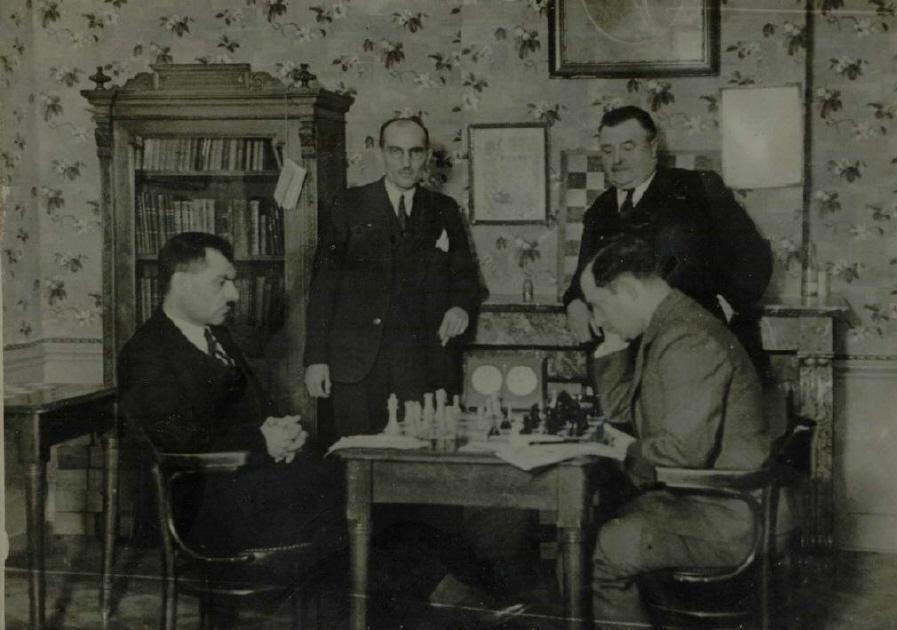
Our correspondent comments:
‘This picture was taken during the third match-game between Victor Soultanbéieff and George Koltanowski in Brussels on 25 June 1935. I received it as a present from the daughter-in-law of Akiba Rubinstein (the widow of his eldest son), and I believe that it has never been published before. The persons standing are Demey and Van Meenen.’
(4701)
Jan Kalendovský has been trying to identify all the figures in the group photograph of Marienbad, 1925:
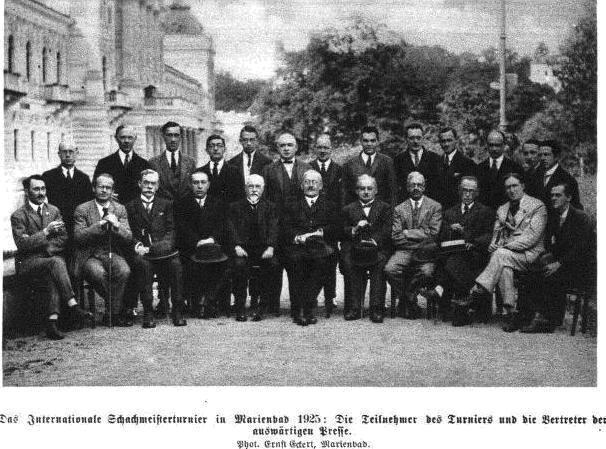
He offers the following:
‘Seated (left to right): N.N., A. Nimzowitsch, R.P. Michell, A. Rubinstein, I. Gunsberg, N.N., V. Tietz, Sir George Thomas, D. Janowsky, F.J. Marshall, F.D. Yates
Standing: L. Burian, H. Kmoch(?), M. Walter, C. Torre, N.N., D. Przepiórka, R. Spielmann, R. Réti, E. Grünfeld, F. Sämisch, S. Tartakower, A. Haida, K. Opočenský.’
The photograph appeared at the start of the tournament book, with the caption ‘Tournament participants and guests’ (‘Teilnehmer und Gäste des Turniers’). Mr Kalendovský reports that it was originally published in the Wiener Bilder, 7 June 1925.
(5119)
Alan McGowan (Waterloo, Canada) mentions that a key to the Marienbad, 1925 group photograph was published on page 89 of the May-June 1925 American Chess Bulletin. The additional information it supplies is:
(5125)
See too C.N. 9844, which includes this photograph from the Marienbad, 1925 tournament book:
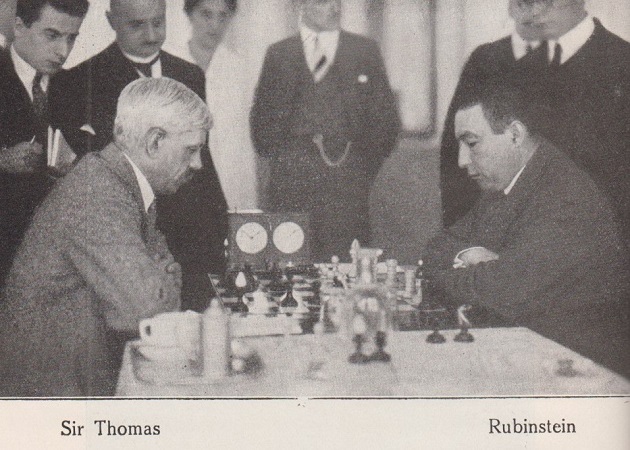
Rubinstein’s inscription in one of our copies of Rubinstein Gewinnt! by Hans Kmoch (Vienna, 1933):
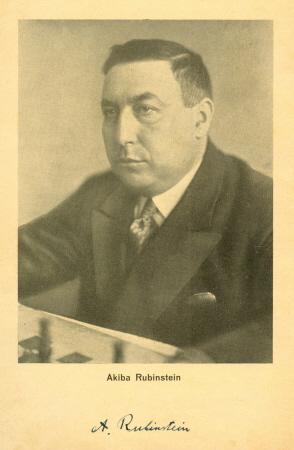
(5250)
From page 333 of the November 1943 Chess Review (an article on Rubinstein by Reuben Fine):
‘When the famous Swedish Laarobok [sic] was being written right after the last war, the sponsor [sic], Colijn [sic], heard that Rubinstein had a copy of the German Handbuch, with various marginal comments. Colijn [sic] bought the book for a fantastic price, about $1,000, but Rubinstein’s “notes” did not cover two pages when they were put together.’
See also page 81 of Fine’s book The World’s Great Chess Games (New York, 1951). What is the basis for his claim?
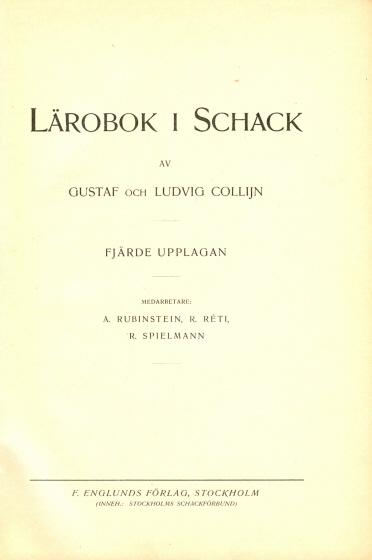
The title page of the fourth (1921) edition
(5542)
From Ola Winfridsson (Cambridge, England):
‘I have found a passage that may shed some further light on the saying “All rook endgames are drawn”, although without nailing the quote as such. In the Göteborg, 1920 tournament book Rubinstein’s notes to the game A. Selesniev v S. Tartakower from round six of tournament A (the grandmaster group) included the following statement in a comprehensive comment on 29...Rc8 (see page 60):
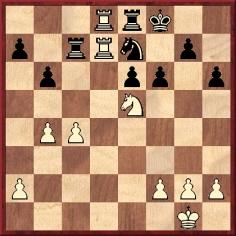
“... Den av svart valda fortsättningen ser bra ut och leder till bondevinst, men därefter återstår blott remisfigurerna, tornen, då en bonde mer sällan räcker till vinst ...” [“... The continuation chosen by Black looks convincing and leads to the win of a pawn. However, this leaves only the drawing pieces, the rooks, when an extra pawn is seldom enough to win ...”]
This would seem to indicate that it was a generally accepted piece of chess wisdom among the leading grandmasters (Tarrasch, Tartakower and now Rubinstein) at the time that rook endings were notoriously drawish in character.’
Olimpiu G. Urcan (Singapore) provides this photograph taken in Göteborg in the early 1920s (Svenska Dagbladet Archive):

Page 156 of Kings, Commoners and Knaves commented:
‘Numerous books assert that Carl Carls always played 1 c4, except on the occasion when his c-pawn was glued to the board. In fact, games in which Carls opened as White with another first move may even be found in the monograph Carl Carls und die “Bremer Partie”.’
A less common tale, on which we have no further information, appeared on page 4 of Relax with Chess by Fred Reinfeld (New York, 1948):
‘The story goes that a practical joker, taking advantage of Akiba Rubinstein’s predilection for 1 P-Q4, once nailed down the grandmaster’s queen’s pawn.’
(6113)
Jonathan Berry (Nanaimo, BC, Canada) asks about the origins of the rule that the game is forfeited by a player who does not come to the board during the first hour of the playing session. Our correspondent believes that this has been termed the ‘Rubinstein rule’, but can any connection with Akiba Rubinstein be established?
(6175)
Stephen Wright (Vancouver, Canada) quotes from page 36 of Chess Canada, September-October 1974, in an article by Bent Larsen entitled ‘Blame it on the Computers’:
‘Rubinstein did not like the public, and in some of his last tournaments he preferred to arrive very late and play quickly, which is the reason for the one hour rule we have now.’
From Robert John McCrary (Columbia, SC, USA):
‘The earliest example of the provision forfeiting a player for arriving one hour late at the board is in the additional rules of the Fourth American Chess Congress (Philadelphia, 1876). Page viii of the tournament book gives that rule, which was added by the players to the original rules, as follows:
“A player coming in one hour after the commencement of the sitting will forfeit the game, subject, however, to an appeal to the committee, who, if his excuse be valid, may decide otherwise.”
A “sitting” referred to each of three segments of four or four-and-a-half hours in one game (allowing for meal breaks), so that a player might forfeit for arriving an hour late to resume a game already in progress after a break.
The first instance of the modern rule that I have seen is rule 12 on page xii of the London, 1883 tournament book. It states that a player arriving late for a game or after the adjournment will have have his clock started, and will forfeit if one hour late; or earlier if he exceeds his 15 moves per hour time-limit after the adjournment even if before the hour. The rule specifies that both players lose if they are both an hour late.
For the period before 1876 I have found only more lenient rules, usually allowing solely for fines for late players. However, at London, 1862 there was a forfeit after five hours, following a grace period of one hour, plus two full time-control periods at 20 moves in two hours. The actual rule, on page lii of the tournament book, concludes:
“In any case he must complete 40 moves within four hours of his glass being set running. Should he not make his appearance within five hours of the time appointed, he shall forfeit the game.”
However, the next rule excludes double-forfeits, saying that the players will be merely fined if both are five hours late. (Players set their own game times by agreement.)’
(6178)
See Chess and Time.
From pages 77-78 of Soultanbéieff’s Guide pratique du Jeu des Combinaisons, in the introduction to his draw against Rubinstein at Liège, 1930 (our translation):
‘Once he had played his move, Rubinstein would leave the table and sit in a corner of the hall. When his opponent’s reply had been made, he came back unhurriedly to the board. The waste of time was evident, and Rubinstein, a very slow player, suffered from it frequently (it is known how many games he lost on time). One day I asked him why he did not remain at the board to await his opponent’s reply, which was sometimes imminent, and the explanation he gave me astounded me in the mouth of a professional master: “So as not to disturb my opponent; some players are not at ease when one watches them thinking.”’
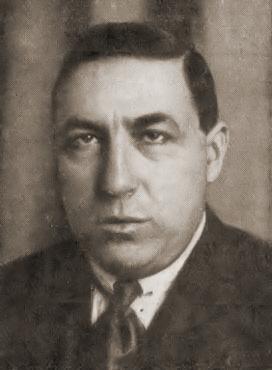
Akiba Rubinstein
(6487)
From page 27 of How to Play Chess Like a Champion by Fred Reinfeld (New York, 1956):
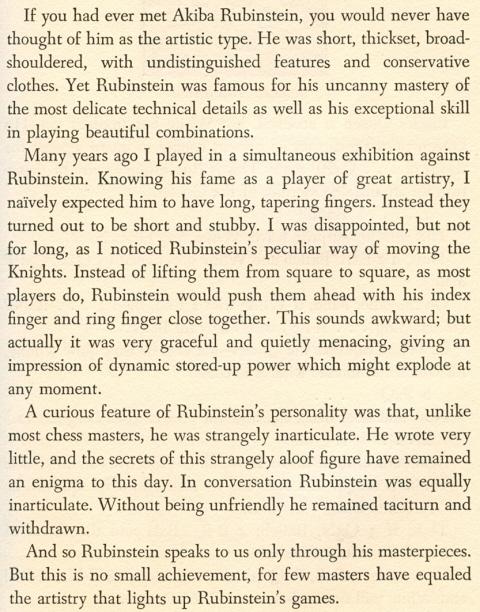
Reinfeld’s game against Rubinstein was played at the Marshall Chess Club in New York on 18 February 1928. Rubinstein’s opponents included E. Tholfsen (one of two winners) and M. Hanauer (one of two players who drew), and among the 20 losers were Reinfeld, H.R. Bigelow, W. Frere, B.M. Anderson, J.C.H. Macbeth and A.E. Santasiere. Source: New York Times, 20 February 1928, sports section, page 17.
Rubinstein’s loss to Tholfsen was given on page 261 of Akiba Rubinstein: The Later Years by J. Donaldson and N. Minev (Seattle, 1995).
Below is a picture of Rubinstein from opposite page 628 of the May 1927 issue of L’Echiquier:
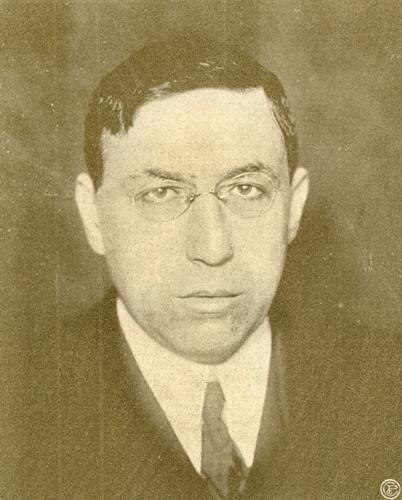
(6518)
A further recollection by Reinfeld, from page 94 of his book Great Moments in Chess (New York, 1963):
‘Many years ago I played against Rubinstein in a simultaneous exhibition. I was almost cross-eyed with reverence for the great man, and, in Frank Marshall’s classic phrase, “he beat me like a child”. One detail still lingers in memory. Though Rubinstein was a stocky man with stubby fingers, his hands maneuvered the chessmen with such elegance that I was spellbound.’
(6633)
David DeLucia (Darien, CT, USA) asks for information about a group picture in his collection.
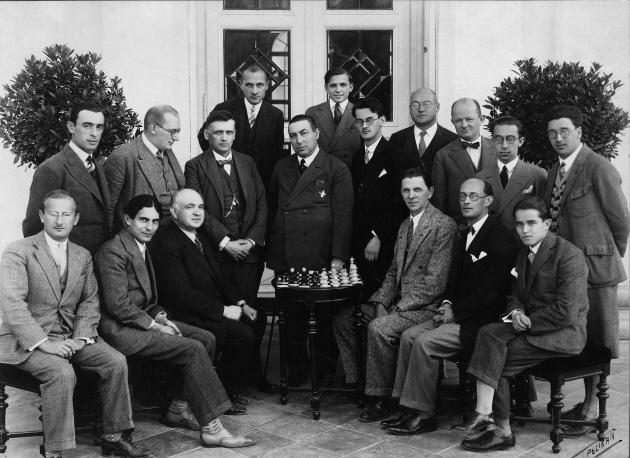
We identify the event as Rogaska Slatina, 1929. Alfred Brinckmann’s tournament book has a different picture, with the figures named:
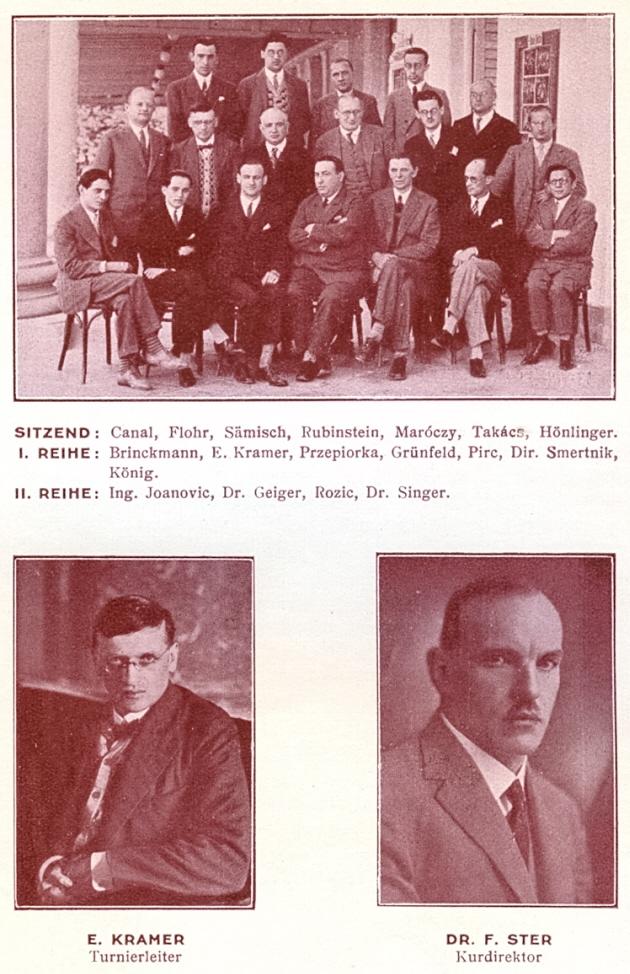
So fine is Mr DeLucia’s photograph that it is possible to produce a good-quality detail of, for instance, Rubinstein:
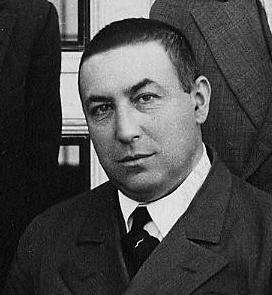
(6863)
From page 399 of The Joys of Chess by Christian Hesse (Alkmaar, 2011):
‘All in all Akiba Rubinstein played 1985 tournament games in his life, of which 1763 had rook endgames.’
The book’s author/compiler does not believe in using primary sources or in specifying his secondary sources for particular items (many positions and other material are taken from Chess Notes, in exchange for a one-line mention of our website in a list on page 427). Since The Joys of Chess gives no source for the Rubinstein statistics, we shall do so. The sentence was written by Irving Chernev on the inside front cover of the July 1952 Chess Review, was reproduced on page 270 of his book The Chess Companion (New York, 1968) and was an obvious joke.
(7083)
John Blackstone (Las Vegas, NV, USA) sends this article from page A11 of the Brooklyn Daily Eagle, 15 October 1922:
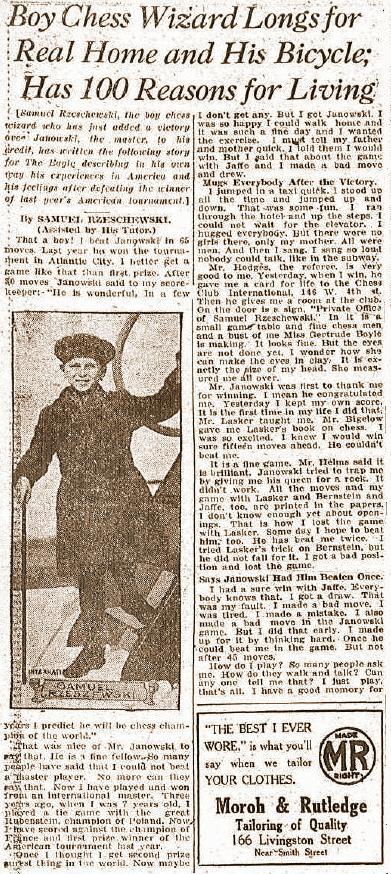
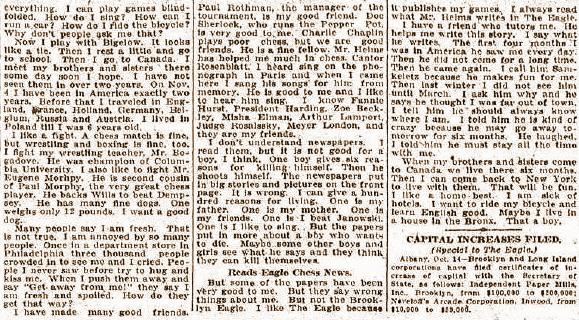
Among the points of interest are the boy’s comments on Janowsky, whom he had defeated in the New York tournament (see C.N. 6083). There is also an apparent reference to having drawn a game against Rubinstein in 1919. We note too the remarks about Charlie Chaplin.
(7236)
1 e4 e5 2 Nf3 Nc6 3 Bb5 a6 4 Ba4 Nf6 5 O-O d6 6 d4 b5 7 Bb3 Nxd4 8 Nxd4 exd4 9 c3 dxc3 10 Nxc3 Be7 11 a4 b4 12 Nd5 O-O 13 Nxb4 Bb7 14 Bd5 Nxd5 15 Nxd5 Rb8 16 b3 f5 17 f3 fxe4 18 fxe4 Rxf1+ 19 Kxf1 Bf6 20 Ra2
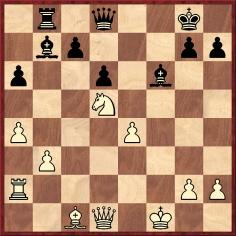
20...Be5 21 g3 c6 22 Ne3 c5 23 Qg4 Bc8 24 Qd1 Bh3+ 25 Ke1 Bc3+ 26 Bd2 Bd4 27 Qc2 Qf6 28 Bc1 Qf3 29 Qd3 Qh1+ 30 Nf1 Re8 31 White resigns.
‘Allies v Rubinstein, Berlin, 1922’ is the only information usually supplied for this game. See, for instance, page 145 of Akiba Rubinstein’s Chess Academy by V. Glatman (Moscow, 1992) and page 250 of Akiba Rubinstein: The Later Years by J. Donaldson and N. Minev (Seattle, 1995).
The allies were named when the game was given on pages 82-83 of Schachjahrbuch 1922 by L. Bachmann (Ansbach, 1924): Wegemund, Wagner, Friedrich and Berggrün. The heading was merely ‘Beratungspartieim Berliner Schachverein von 1876’ and the source indicated was the Vossische Zeitung. Can further particulars about the game be found there?
(7245)
Graced with some exceptionally rich archive material, Liz Garbus’s 2011 documentary film Bobby Fischer Against the World is disgraced with some exceptionally poor interviewees. A particular low point, with some of the talking heads less concerned about being truthful than noticed, is the dense sequence which seizes on the issue of insanity:
... Asa Hoffmann: ‘Rubinstein jumped out of the window because the fly was after him.’
(7345)
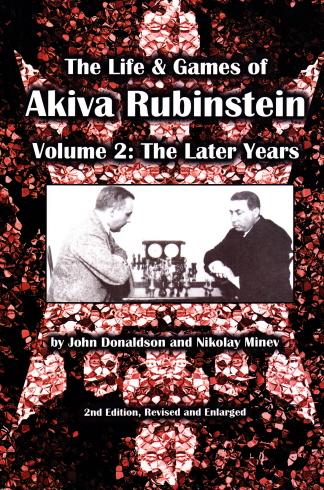
From page 9 of volume two of The Life & Games of Akiva Rubinstein by John Donaldson and Nikolay Minev (Milford, 2011):
‘Rubinstein: 100 de sus mejores partidas recopiladas y una nota biográfica, authored by Jaime Baca-Arús and José Ricardo López, and published in Havana in 1922, has long been thought to be the first book to be published on Rubinstein but that is not in fact the case. John DeArman’s Rubinstein’s Games of Chess: A very incomplete collection of the match and tourney games of a great master was printed ten years earlier in Pasadena, California.
This has to be one of the rarest chess books in the world and it is quite possible the Los Angeles Public Library holds the only copy. The catalogue lists the book as 236 pages long, but actually this is only the number devoted to games; another 36 pages of flowery prose precede it. The book is a little smaller than the fourth edition of Modern Chess Openings, about 6½ by 4 inches (16.5cm x 10.2cm), but is packed with information. While DeArman has nothing original to offer he did do a first rate job of gathering information from many sources including the Deutsche Schachzeitung, the American Chess Bulletin and tournament books for many of the events Rubinstein played in ending in 1911.
This is not the only book that DeArman published. The Los Angeles Public Library also has his works on Nuremberg 1906, Hamburg 1910, San Sebastian 1911 and The Kings of Chess. The latter is an updated translation of a work by J. Rademacher (1905), published by DeArman in 1910, listing the tournament and match records of every master who has gained a prize in any international tournament. This is the only work of DeArman listed in the Cleveland Public Library catalogue for the John G. White collection.
The authors would be very interested in hearing from readers who have any information on DeArman, who is quite a mystery. His name does not produce any hits on Google nor did he play in any of the Northern California-Southern California chess matches between 1912 and 1926.’
(7572)
From Hans Renette (Bierbeek, Belgium):
‘At the end of 1926, just after a tournament in Berlin, A. Rubinstein and his family moved to Belgium, where they took up permanent residence. In early December 1926 they arrived in Antwerp.
In those days, every foreign citizen who spent time in Antwerp received a visit from the local police. A file was opened, in which the police recorded information about the family’s situation and the professional activities of any foreign visitor. These documents have been preserved in the city archives of Antwerp, as part of the police archives. In cooperation with Familysearch.org, the indexes have been digitized and can be consulted online (“Antwerp Police Immigration Index, 1840-1930”).
A report on the interview with Rubinstein by the Antwerp police is dated 17 December 1926. He declared that he had arrived in the city on 4 December 1926 and gave his previous address as Brinkmanstrasse 5, Berlin. In Antwerp the Rubinsteins lived in the Taverne Old Tom hotel, De Keyzerlei 53, the main street leading from the railway station.
The police documentation includes a brief overview of the Rubinstein family. His father, Akiwa, was born in Grajewo, Poland and was deceased. His mother, Reisel Denenburg, was 80 years old and lived in Jerusalem. Rubinstein was in Antwerp with his wife Eni Lew (born in Szczuczyn, 16 June 1893) and their only child, Jakob (born in Szczuczyn on 24 January 1918). The couple had married in that city on 30 March 1917.
Asked about his professional activities, Rubinstein stated that he was a chess teacher. The police report also mentioned that he had no fixed income.
The police report came to the attention of the “Public Security” section of the Ministry of Justice. On 21 February 1927 the Ministry sent the police a request for more information. It seems that Rubinstein’s address in Berlin was checked and that his residence there was unknown to the German authorities. (In this connection, the second entry for Rubinstein in Where Did They Live? may be noted.)
A reply to the Ministry was written by the police on 27 February 1927. It stated that the Rubinsteins had left the hotel, having been there from 4 December 1926 until 3 January 1927. During the Rubinsteins’ stay, the police said, there had been no complaints about their behaviour. No further information had been obtained about their means of subsistence, and the police did not know where the family had gone.’
(7810)
The entries in our above-mentioned Where Did They Live? feature article:
Kilińskiego 47, Szczuczyn, Gouv. Lomza, Poland (Ranneforths Schach-Kalender, 1922, page 117).
Brinkmannstrasse 6, Potsdam-Rehbrücke, Germany (acht x acht Zur Kunst des Schachspiels by E. Strouhal (Vienna, 1996), page 111). Address from 1922 to 1926.
26 avenue de Dixmude, Antwerp-Berchem, Belgium (Ranneforths Schachkalender, 1932, page 111).
46 rue Château d’Eau, Uccle, Brussels, Belgium (Chess Review, March 1948, page 1).
On page 34 of the February 1935 Chess Review Irving Chernev wrote in a ‘Curious Chess Facts’ column:
‘Rubinstein, playing a rook ending against Mattison, extracted a win from such a “hopelessly drawn” position that the editors of the tourney book united in the assertion that had this occurred 300 years ago, Rubinstein would have been burned as being in league with evil spirits.’
Chernev used a slightly different wording on page 58 of his book Curious Chess Facts (New York, 1937):
‘Rubinstein, playing a rook and pawn ending against Mattison, extracted a win from such a “hopelessly drawn” position that the editors of the tournament book united in the assertion that had this happened 300 years ago, Rubinstein would have been burned at the stake for being in league with evil spirits.’
Below are three instances of Chernev’s text being copied (without attribution, of course):
‘At Carlsbad, 1929 Rubinstein extracted a win from such a “hopelessly drawn” rook and pawn ending that the editors of the tournament book united in the assertion that had this happened 300 years ago Rubinstein would have been burned at the stake for being in league with evil spirits.’
Source: page 15 of New Ideas in Chess by Larry Evans (New York, 1958).
‘At Carlsbad, 1929 Rubinstein extracted a win from such a “hopelessly drawn” rook-and-pawn ending that the editors of the tournament book united in the assertion that had this happened 300 years earlier Rubinstein would have been burned at the stake for being in league with evil spirits.’
Source: page 133 of Chess Catechism by Larry Evans (New York, 1970).
‘At Carlsbad, 1929 Rubinstein extracted a win from such a “hopelessly drawn” rook and pawn ending that the editors of the tournament book united in the assertion that had it happened 300 years ago he would have been burned at the stake for being in league with evil spirits.’
Source: pages 19-20 of Modern Chess Brilliancies by Larry Evans (New York, 1970).
(7811)
Another one:
‘At Carlsbad, 1929 Rubinstein extracted a win from such a “hopelessly drawn” rook-and-pawn ending that the editors of the tournament book united in the assertion that had it happened 300 years ago he would have been burned at the stake for being in league with evil spirits.’
Source: page 33 of The Chess Beat by Larry Evans (Oxford, 1982).
Olimpiu G. Urcan provides the following:
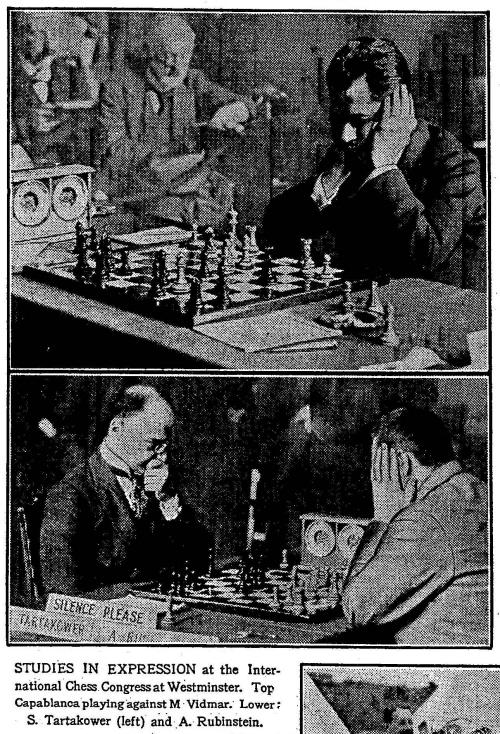
The Times, 17 August 1922, page 12
As ever in such cases, information about copies of better quality will be appreciated.
(8178)
A good copy of the photograph of Capablanca is given in London, 1922.
Asked about chess books which had a profound influence on him, John Nunn replied (see the 3/2002 New in Chess, page 98):
‘When I was a young player, I read The Most Instructive Games of Chess Ever Played by Irving Chernev which made chess seem extremely easy. However, I then read Alekhine’s Best Games of Chess, which made chess seem impossibly difficult. I eventually discovered that the truth lies somewhere between the two.’
Dr Nunn informs us:
‘I was referring to the 1924-37 volume by Alekhine. I recall being particularly impressed by 18...Nxf2 in Rubinstein v Alekhine, Semmering, 1926, or rather the fact that Alekhine must have seen it some time in advance.’
(8196)
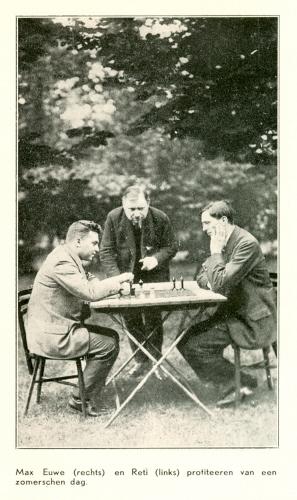
C.N.s 5187 and 5197 gave the above photograph, taken from Aljechin-Euwe by Guus Betlem Jr (Helmond, 1936), and in the latter item Peter de Jong (De Meern, the Netherlands) suggested persuasively that the figure standing between Réti and Euwe was Willem Schelfhout.
Mr de Jong now forwards another picture, from page 4 of De Telegraaf (morning edition), 12 July 1923:
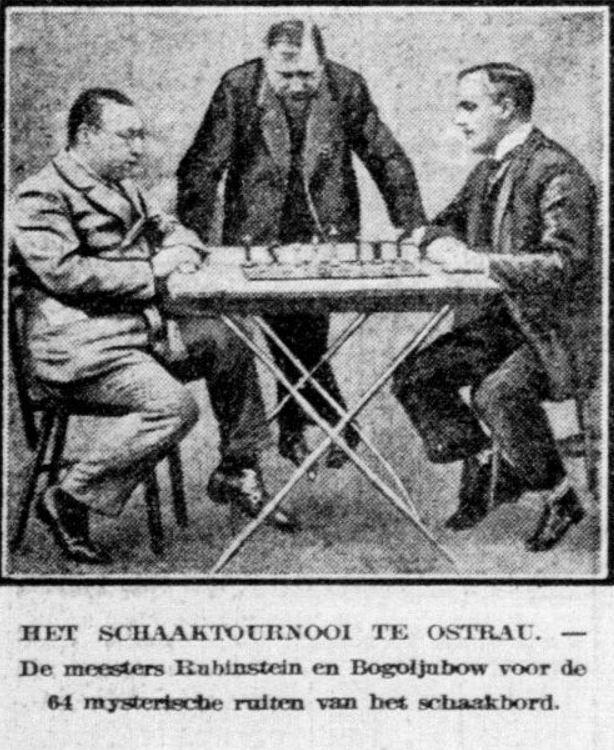
The setting and furniture being similar, our correspondent concludes that the Réti v Euwe picture was also taken during the Mährisch-Ostrau, 1923 tournament.
(8355)
A detail of Rubinstein from the Carlsbad, 1911 group photograph (Wiener Schachzeitung, September-October 1911, pages 304-305):
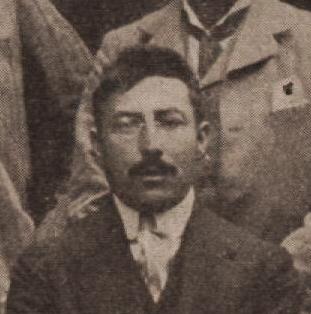
(8574)
Christian Sánchez (Rosario, Argentina) notes that yet another master who expressed opposition to Capablanca’s proposals was Rubinstein, as reported on page 4A of the Brooklyn Daily Eagle, 16 February 1928.

(8689)
See Chess Variants and Rule Changes.
From page 58 of Blunders and Brilliancies by Ian Mullen and Moe Moss (Oxford, 1990):
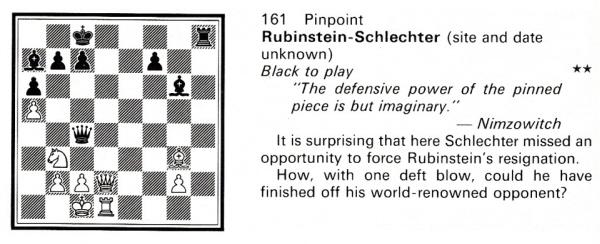
The co-authors did not state their source for the position. Such a finish (with the move ...Be3 overlooked) did occur in a game (Berlin, 1918) between the players named, but Schlechter was White. The position, moreover, was slightly different:
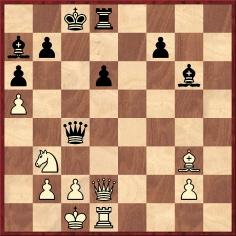
The game was annotated by Emanuel Lasker (who mentioned the players’ extreme time-trouble at move 30) on pages 14-15 of Das Großmeister-Turnier im Kerkau-Palast zu Berlin im Oktober 1918:
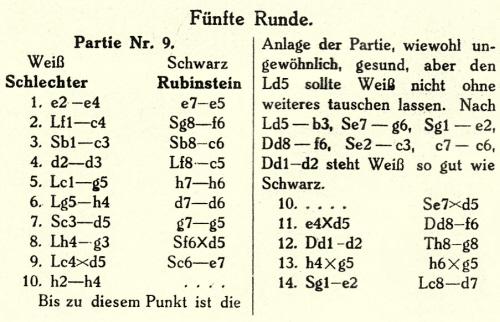
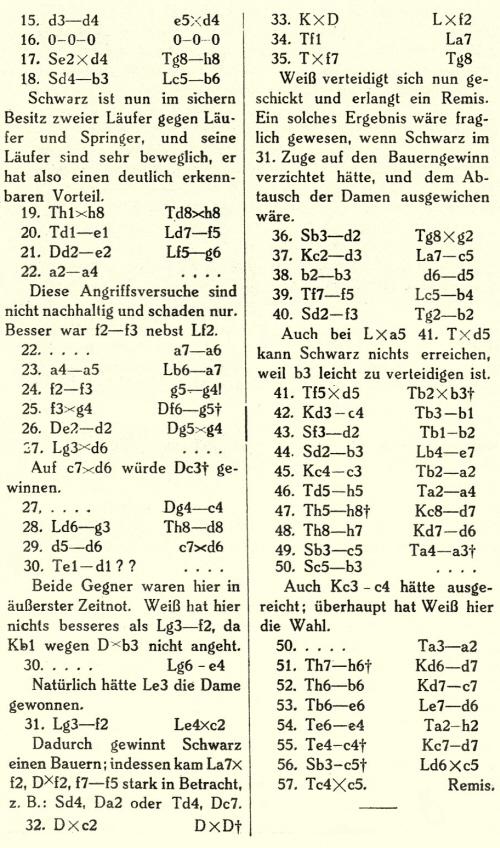
See too page 321 of volume one of The Life & Games of Akiva Rubinstein by John Donaldson and Nikolay Minev (Milford, 2006).
(8715)
‘One of the most original games ever played, and one of the finest examples of cool, resourceful chess under very trying circumstances.’
That was the concluding remark by Fred Reinfeld about a game which he annotated on pages 69-73 of How to Play the Black Pieces (New York, 1955):
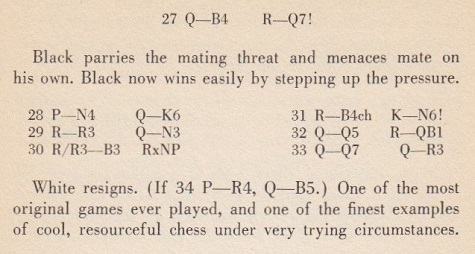
The players were not named, but the game was Spielmann v Tartakower, Copenhagen, 1923. Tartakower gave only the conclusion on page 115 of My Best Games of Chess 1905-1930 (London, 1953):
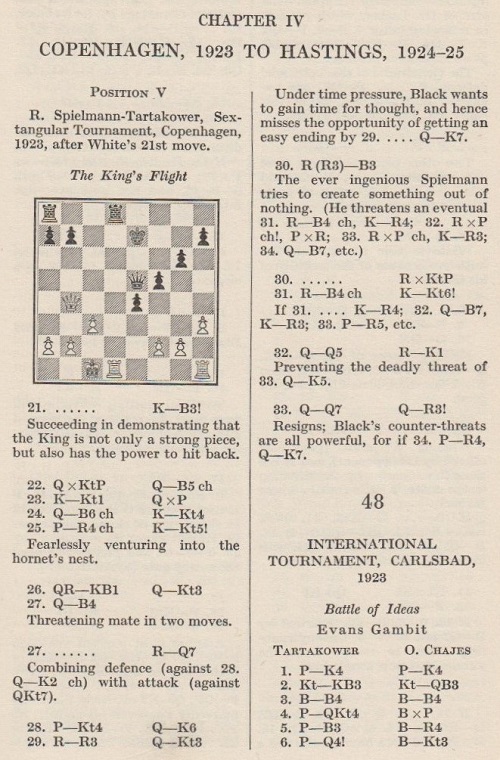
The full game was annotated by Tartakower on pages 35-36 of the April 1923 issue of the Wiener Schachzeitung:
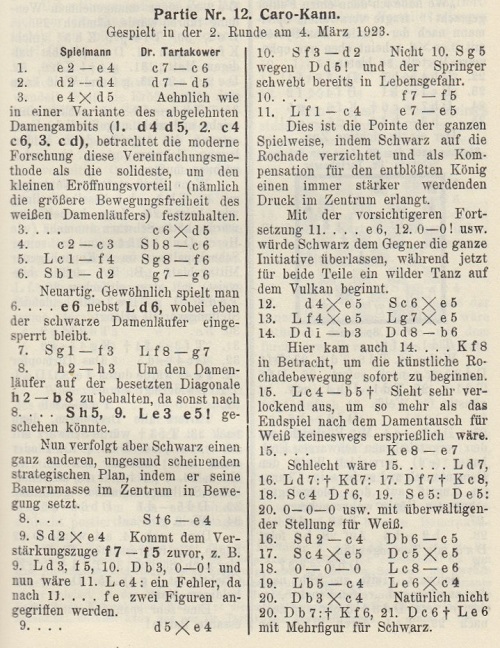
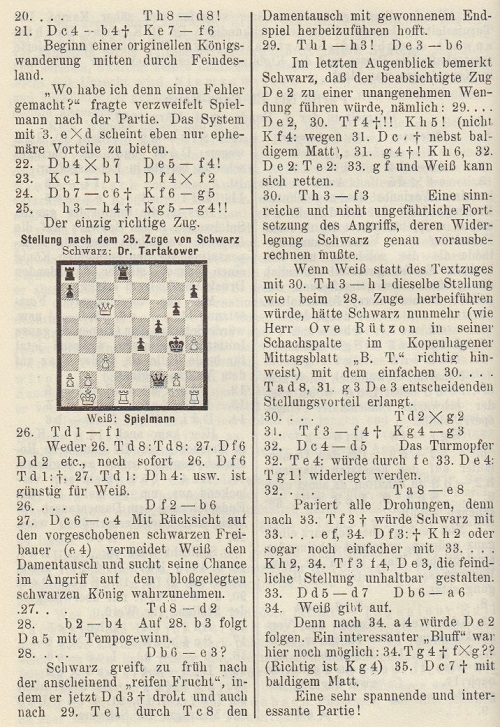
The ‘bluff’ mentioned in the final note is of particular interest, and it will be seen that in both publications Tartakower gave his 32nd move as ...Ra8-e8. Reinfeld, however, put ‘...R-QB1’, and that was also the move in the tournament book, where notes by Rubinstein were given on pages 9-10:
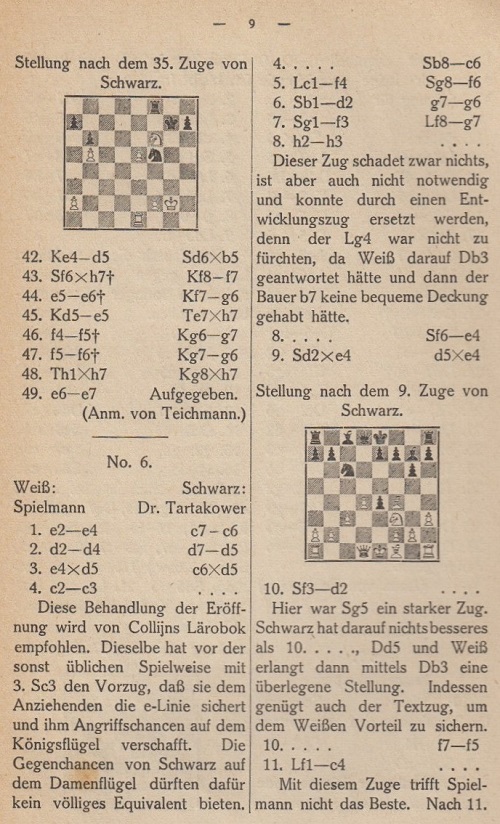
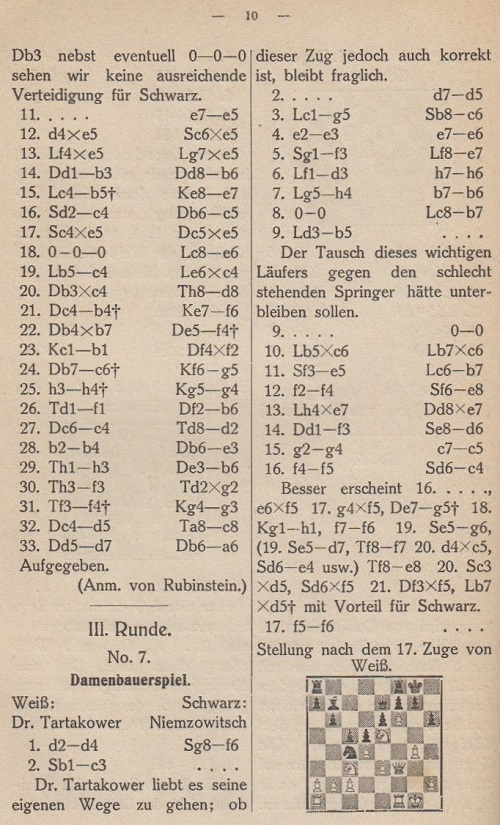
The improbable 32...Rc8 could be answered by 33 Rxe4.
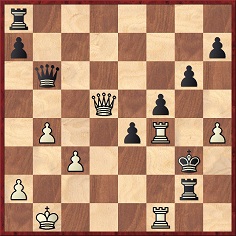
Position after 32 Qd5
The score as published by Tartakower in 1923: 1 e4 c6 2 d4 d5 3 exd5 cxd5 4 c3 Nc6 5 Bf4 Nf6 6 Nd2 g6 7 Ngf3 Bg7 8 h3 Ne4 9 Nxe4 dxe4 10 Nd2 f5 11 Bc4 e5 12 dxe5 Nxe5 13 Bxe5 Bxe5 14 Qb3 Qb6 15 Bb5+ Ke7 16 Nc4 Qc5 17 Nxe5 Qxe5 18 O-O-O Be6 19 Bc4 Bxc4 20 Qxc4 Rhd8 21 Qb4+ Kf6 22 Qxb7 Qf4+ 23 Kb1 Qxf2 24 Qc6+ Kg5 25 h4+ Kg4 26 Rdf1 Qb6 27 Qc4 Rd2 28 b4 Qe3 29 Rh3 Qb6 30 Rhf3 Rxg2 31 Rf4+ Kg3 32 Qd5 Re8 33 Qd7 Qa6 34 White resigns.
It was played in the same tournament as the Sämisch v Nimzowitsch ‘Immortal Zugzwang’ encounter, and neither game was widely published at first.
(9679)
Harvard Library’s HOLLIS+ collection has photographs of A. Rubinstein in Tel Aviv in 1931, during a simultaneous exhibition (one of his opponents being Hayim Nahman Bialik) and a game of living chess.
The site also has hundreds of shots taken during the 1964 Olympiad in Tel Aviv.
(9850)
Regarding the second photograph referred to in C.N. 9850, Avital Pilpel draws attention to two pages on his Jewish Chess History website. They offer information about (1) the venue of the game of living chess between A. Rubinstein and M. Marmosh (the Ha’Poel football ground in Tel Aviv, on 9 May 1931) and (2) Emanuel (Emanueli) Luftglas, who designed the costumes.
See too the ‘Rubinstein in Palestine’ section on pages 368-371 of volume two of The Life & Games of Akiva Rubinstein by John Donaldson and Nikolay Minev (Milford, 2011).
(9854)
Another stamp in the Austrian series (see C.N.s 3680, 3681 and 3689, as well as Chess and Postage Stamps) had a well-known photograph of Rubinstein and Mieses:
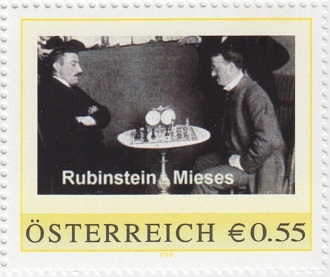
(9904)
From Gerard Killoran (Ilkley, England) comes a report about a 22-board simultaneous exhibition by Akiba Rubinstein in Burnley on 12 February 1925, from page 6 of the Burnley News, 18 February 1925:
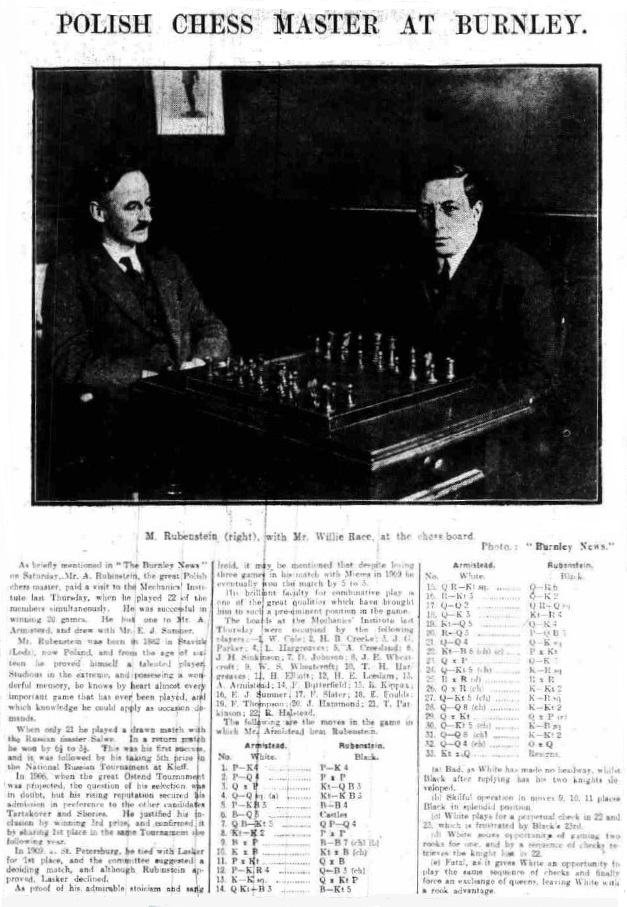
A. Armistead v A. Rubinstein:
1 e4 e5 2 d4 exd4 3 Qxd4 Nc6 4 Qd1 Nf6 5 f3 Bc5 6 Bd3 O-O 7 Bg5 d5 8 Ne2 dxe4 9 Bxe4
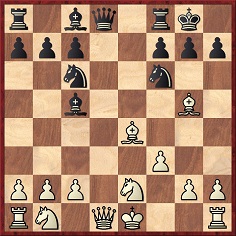
9...Bf2+ 10 Kxf2 Nxe4+ 11 fxe4 Qxg5 12 h4 Qf6+ 13 Ke1 Qxb2 14 Nbc3 Bg4 15 Rb1 Qa3 16 Rb3 Qe7 17 Qd2 Rad8 18 Qe3 Na5 19 Nd5 Qe5 20 Rd3 c6 21 Qd4 Qe8
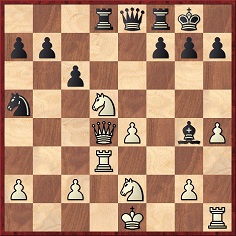
22 Nf6+ gxf6 23 Qxf6 Qe6 24 Qg5+ Kh8 25 Rxd8 Rxd8 26 Qxd8+ Kg7 27 Qg5+ Kh8 28 Qd8+ Kg7 29 Qxa5 Qxe4 30 Qg5+ Kf8 31 Qd8+ Kg7 32 Qd4+ Qxd4 33 Nxd4 Resigns.
We note that the photograph and game (with almost identical annotations) had been given on page 15 of the Burnley Express and Clitheroe Division Advertiser, 14 February 1925. It stated that Willie Race ‘acted as interpreter, as the chess master speaks no English’.
A slightly clearer version of the photograph of Race and Rubinstein:
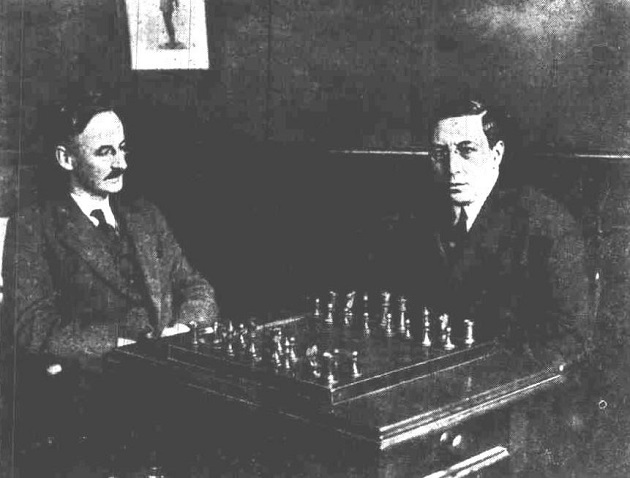
(10053)
From an article by Tartakower, ‘Secrets of San Remo, 1930’, on pages 421-424 of CHESS, 20 August 1939:
‘Coming second in so important a competition, Nimzowitsch was considered the prince of chess. Nevertheless he was less dangerous to Alekhine throughout the tournament than Rubinstein, who had the chance, two rounds before the end, of catching up with the leader. That is why in the game Alekhine-Rubinstein played in the 14th round – the one before the last – it appeared to be to Alekhine’s advantage to try for a draw, which would give him first prize, rather than chase an uncertain win. When somebody suggested to Rubinstein before the game that he would do well to accept such a pacific situation the great Akiba replied, “A Rubinstein always plays to win”.
Lacking thus a quiet and objective outlook, Rubinstein fell into an opening trap which cost him a pawn and, despite a heroic resistance, the game.’
Concerning that game, see The Rubinstein Trap. With regard to Tartakower’s comments about the standings, it should be noted that before the 14th round Alekhine led with 12 points, followed by Nimzowitsch and Rubinstein (9 points). Alekhine won the tournament by a 3½-point margin.
(10489)
In connection with Pistyan, 1912, Jan Kalendovský gives this photograph from page 511 of Vasárnapi Ujság, 23 June 1912:
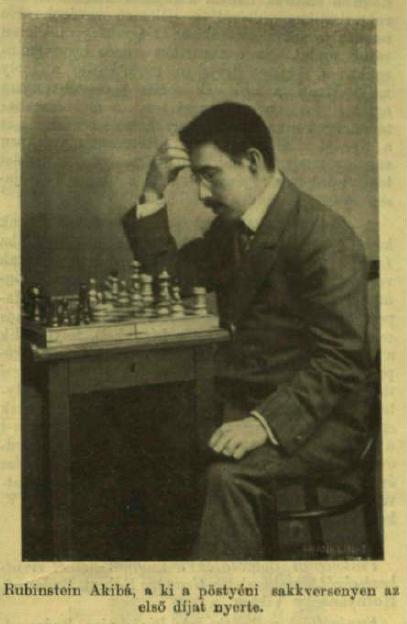
(10609)
Our translation of comments by Capablanca about Rubinstein on pages 3-5 of Capablanca-Magazine, 25 April 1912, in an article on San Sebastián, 1912:
‘Rubinstein, who, at the chess board, is the glory of Russia, was born in Łódź in 1882 [sic], and is thus 30 years old. He is extremely astute and a profound student of the game; it is related that he studies for two or three hours every morning; he is a great admirer of Morphy, whose games he probably knows by heart. He is very observant and when, in San Sebastián in 1911, I was amusing myself playing fast games against Dr Bernstein, his compatriot, he always came to watch the contest, often making the observation that I possessed tactical ability superior to anyone else’s. This is clear proof of the great Russian expert’s modesty.
Rubinstein has made a special study of the queen’s pawn opening, and his opponents can be entirely sure that as White he will open with 1 d4. There have been occasions when he has varied, but these have been rare. With Black he almost always plays the French Defence against 1 e4 and he has made a special study of this opening too.
His openings are irreproachable because he plays only what he has studied in the greatest depth. His middle-game play is worthy of the great master that he is, while it is generally agreed that he is extraordinarily strong in the endgame. From this it may be deduced that the Russian master is very difficult to defeat. To beat him it is necessary to proceed step by step and with great care because he is forever preparing traps for his opponent.
His main successes have been Carlsbad, 1907, first prize; Ostend, 1907, first and second prizes equal with Bernstein; St Petersburg, 1909, first and second prizes equal with Lasker, the world champion, whom he beat in their individual game; San Sebastián, 1911, second and third prizes equal with Vidmar, and finally San Sebastián, 1912 first prize.
Rubinstein has never been lower than third in an international tournament, which is a record matched by no other player except Lasker. Today Rubinstein is, in my opinion, the strongest European player, leaving aside Lasker, who, as world champion, has the right to be considered the first.’
Olimpiu G. Urcan notes that a search for sakk on the Magyar Világhíradók website provides film coverage of Budapest, 1928 (notably featuring Capablanca) ... as well items with footage of Maróczy, Réti, Rubinstein and Tartakower.
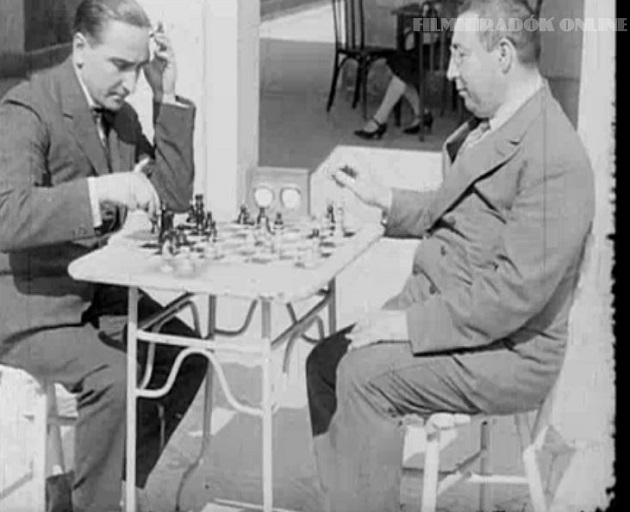
(10764)
From Walter Penn Shipley’s chess column in the Philadelphia Inquirer, 6 February 1927 (page 3, puzzle section):
‘Janowsky had a very high opinion of Rubinstein and considered the Polish master one of the best living exponents of the chess openings. He told the editor of this column a few years ago when they met in New York that all the great masters at that time studied Rubinstein’s openings.’
(10864)
The first paragraph of W.H. Watts’ ‘General Account of the Tournament’ in the Hastings, 1922 book by Alekhine:
‘During the early days of the London International Tournament of 1922 it was rumoured that the energetic Hastings Club were organizing a Masters’ Tournament. It was hoped that the participation of both Capablanca and Lasker would be secured, but first one and then the other dropped out for reasons it is unnecessary to go into here.’
In fact, plans for a tournament in Hastings involving Capablanca, Lasker, Alekhine and Rubinstein were in the public domain well before London, 1922 began. Page 257 of the June 1922 Chess Amateur carried a report from the Morning Post that the plan ‘aims at no less than a World Champions’ tournament. The present and past champions and the two candidates for the title ...’:
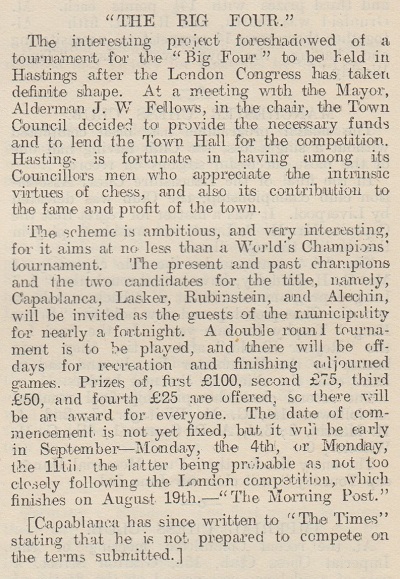
From page 9 of the 20 May 1922 edition of the Hastings and St Leonards Observer:

Capablanca’s refusal to participate was explained in detail in a letter published on page 7 of The Times, 26 May 1922, which is on page 120 of our book on the Cuban.
(10960)
Feature articles about bas de gamme chess writers can only scratch the surface, usually examining their books rather than, even more masochistically, their routine ‘journalism’. Most of Koltanowski’s output that we have seen comes from his anthologies; the thought of trawling through old newspapers for the run of his syndicated columns is unappealing.
Koltanowski’s books ought to contain the cream of the crop, but they have far too many untrue or unauthenticated yarns to be accommodated in an article. Here, we add a passage regarding Akiba Rubinstein from page 126 of With the Chess Masters (San Francisco, 1972):
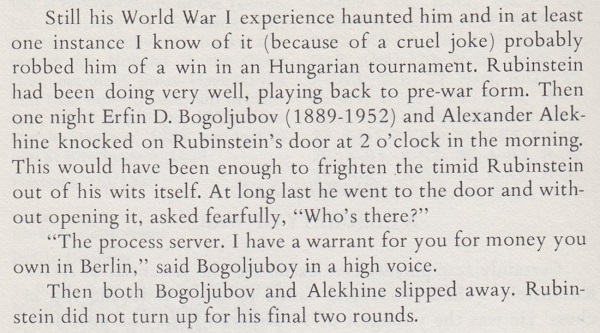
The story was reproduced on page 3 of Akiba Rubinstein: The Later Years by J. Donaldson and N. Minev (Seattle, 1995) with, generously, silent corrections to Koltanowski’s spelling, grammar and punctuation. It was then demolished.
(10980)
A rare interview with Akiba Rubinstein, from page 2 of Die Stunde, 4 July 1926:

Rubinstein’s game against Colle, a 30-move draw, was played on 29 June 1926, as shown on page 30 of the Lachaga tournament book.
(11354)
Cases of an early agreement to a draw were discussed in C.Ns. 8162, 8167 and 8169.
C.N. 2549 (see page 359 of A Chess Omnibus) quoted this remark on Rubinstein by L. Steiner on page 54 of the March 1961 Chess World:
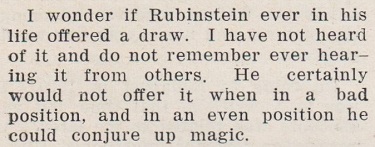
From page 180 of My Best Games of Chess 1905-1930 by Savielly Tartakower (London, 1953):
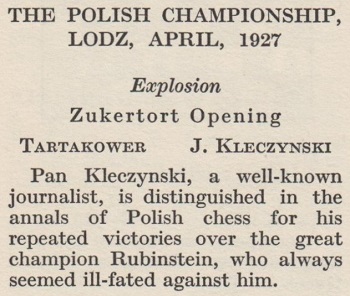
Jan Kleczyński defeated Rubinstein in a well-known game in that Łódź tournament, but what grounds exist for Tartakower’s remark about ‘repeated victories’?
(11610)
A photograph of H. Rose is requested in view of this paragraph on page 152 of Chess Memoirs by Joseph Platz (Coraopolis, 1979), introducing a game apparently played in 1967:
‘My opponent in the next game bore a striking resemblance to Akiba Rubinstein, one of the greatest of all chess masters. It was in the New England Championship in 1954 when I played him for the first time. I beat him with comparative ease. After the game I told him: “You look like Rubinstein, but you don’t play like Rubinstein.”’
(11718)
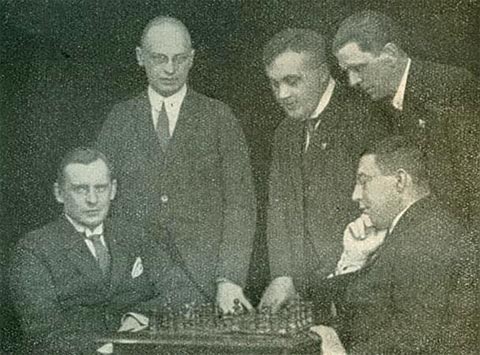
This picture was given by us in a Chess Mysteries article at ChessBase.com on 20 November 2007 with this brief information:
The photograph above shows Alekhine at the board with Rubinstein (watched by Tartakower, Bogoljubow and Maróczy). It is taken from Tartakower’s book Die Hypermoderne Schachpartie, published in the mid-1920s, and the credit reads ‘Friedmann, Wien’. Can a better copy of the picture be found?
Now, Philip Jurgens (Ottawa, Canada) asks whether anything further has come to light. Unfortunately not, to our knowledge.
(11948)
Olimpiu G. Urcan has provided this photograph of Bogoljubow and Rubinstein which he owns. Exact details of the occasion are sought.
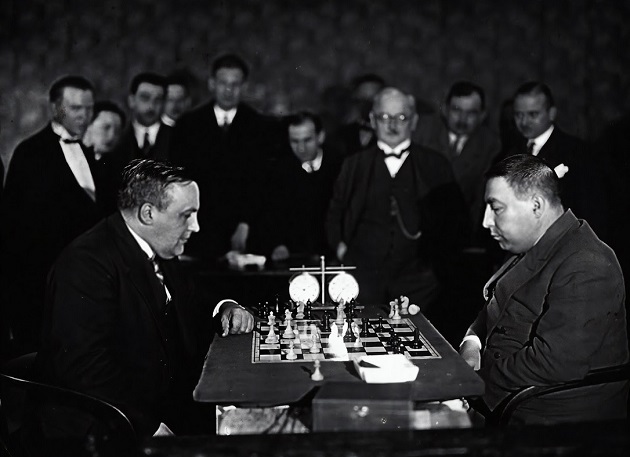
(11995)
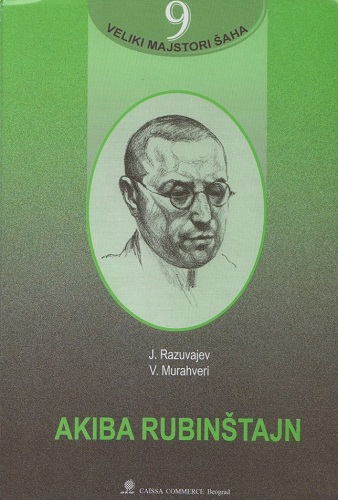
Any chess-related information about William Herbert Wallace (1878-1933) and the Wallace Murder Case is of interest, and here we show a number of local newspaper cuttings from the time when he was a member of the Central Chess Club in Liverpool.
From the Liverpool Post & Mercury, 27 February 1930, page 14:

Five years previously, Akiba Rubinstein had visited the city for a series of chess engagements. As marked in red below, two of the newspaper reports, on 27 February and 6 March, included the name Wallace:

Evening Express (Liverpool), 20 February 1925, page 6

Liverpool Post & Mercury, 25 February 1925, page 10

Liverpool Echo, 25 February 1925, page 7

Liverpool Post & Mercury, 26 February 1925, page 11

Liverpool Post & Mercury, 27 February 1925, page 13

Liverpool Post & Mercury, 28 February 1925, page 9

Liverpool Post & Mercury, 28 February 1925, page 11

Liverpool Post & Mercury, 6 March 1925, page 10.
(12101)
We are authorized to show this portrait of Akiba Rubinstein held by the Jewish Museum of Belgium:

(12131)
From Philip Jurgens (Ottawa, Canada):
‘The portrait of Rubinstein is intriguing. Although the location and date may seem unclear, I recall the photograph of Rudolf Spielmann provided by Jan Kalendovský in C.N. 6131 in connection with Magdeburg, 1927, from page 4 of Wiener Bilder, 7 August 1927:
It is not only the chessboard and background that are similar in the two photographs. Remarkably, even the position appears to be the same, showing the conclusion of the fourth-round game in Berlin, November 1926 in which Rubinstein was White against Grünfeld. The handwritten note on the bottom border of the Rubinstein picture matches the credit on the Spielmann photograph: “Atlantic Photo Co., Berlin”.
Rubinstein did not participate in Magdeburg, 1927, which Spielmann won. However, they did both play in the November 1926 tournament in Berlin, meeting in round one.’
(12187)
See also Akiba Rubinstein’s Later Years.
To the Archives
for other feature articles.
Copyright Edward Winter. All rights reserved.